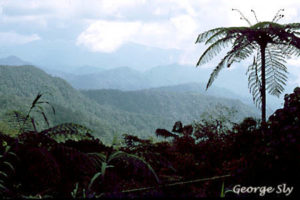It was along a back road in rural Oklahoma that I received the greatest fright ever bestowed upon me by a snake. Strange to say having dealt with such lethal serpents as rattlesnakes, water moccasins, cobras, and kraits, but this fellow (or so I call it) was just an ordinary “ole” colubrid.
You may first rightly ask, what is a colubrid? A colubrid is simply a member of a certain taxonomic family (Colubridae) of snakes. About eighty percent of all the snake species in the world are colubrids. These are typically the common, non-venomous (with certain potentially deadly exceptions) snakes of the world. And yes, I know that the question of which snakes are venomous is a whole other topic for discussion. In our area of southwestern Indiana, typical colubrids would include the prairie kingsnake, garter snake, black rat snake, and northern water snake. These are snakes that simply 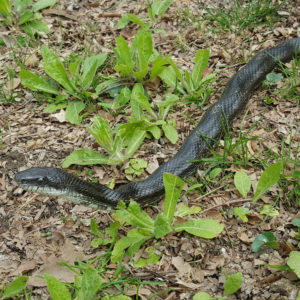 don’t deserve the fear many people experience should they come upon one of them.
don’t deserve the fear many people experience should they come upon one of them.
My tale begins along a remote, gravel backroad in Oklahoma. A summer road trip embarked upon with my graduate school advisor John Whitaker was the motive. Our destination was Texas A&M University in College Station. This was the site of the annual convention of the American Society of Mammalogists. It was a journey I had anticipated with much excitement as the gathering was sure to draw the top mammal scientists in the country. At that stage of my life, I couldn’t get enough of the research regarding such esoteric topics as the food habits of the short-tailed shrew, the territorial behavior of chipmunks, or the ecological relationships of woodland mice.
The trip down there was a jaunt of around nine hundred miles. We traveled in one of the venerable VW minibuses belonging to Indiana State University’s life science department. Dr. Whitaker was not about to let all of the intervening territory between Indiana and Texas pass by without sampling its small mammal fauna. No barrier was too great to stop his quest for specimens for our collections. I once saw him dig a pocket gopher from its burrow with his bare hands. I’m not kidding. It was like watching the speed and power of the bionic man, Steve Austin, in the old TV series The Six Million Dollar Man. I also have a distinctly imprinted memory of him sprinting through the Texas scrub like an Olympian in pursuit of a fleeing nine-banded armadillo. The armadillo lost.
John was also the most intensely hard-working, diligent scientist with whom I’ve had the pleasure of associating. As a student, and as an adult, I’ve found myself to be alarmingly prone to bouts of daydreaming and flights of fantasy. Thus if one was to surreptitiously observe me, I might be found idly sitting at my desk staring, with discouraging regularity, off into space. In contrast, throughout the years I worked with Dr. Whitaker, I was amazed to never find him in a similar state of reverie. I know he must have done so. The devotion of time to contemplating, hypothesizing, or just plain thinking about things are necessary commitments for a scientist. Yet, I never walked into his office to find him idle. On every occasion, throughout the years, he would be busily examining mites beneath his microscope, engaged in typing the text of one of his hundreds of research papers, or pouring over the rough draft of a research project submitted by one of his graduate students. He simply had the most strenuous work ethic I’ve ever seen. And so, there were small mammals to be collected on the way to Texas.
Our routine was to drive an allotted number of hours and check into a motel. We would then cruise into the surrounding countryside to look for a place to set traps. John is a specialist in the arcane world of small mammals, shrews and mice. He is also one of the world’s leading experts on the food habits and parasites of bats. However the latter mammals require more specialized collecting equipment so, on this trip, it was mice and shrews. The animals we sought would be used to enrich the storehouse of mammal specimens in the vertebrate collections at Indiana State. The device we used for capture was the simple mouse trap baited with peanut butter. I suppose the biggest difference in our collecting with mouse traps and that which you might pursue in your house was a matter of numbers. Whereas you might be satisfied with two or three traps strategically placed along a baseboard or in a cabinet, John was a bit more industrious. He had brought along several hundred mouse traps and these we dutifully set each evening after finding lodging. Once the traps had been set, we would venture back to town for dinner. Having eaten, we would go back to the trap line, collect any specimens taken, and pick up our traps.
Back at the motel we would then check the mice and shrews for parasites, record standard measurements of the specimens, and then prepare study skins of the various specimens. This was done by removing the skin and fixing it over a cotton form we constructed which approximated the size and shape of the original animal. Left to dry, these museum specimens would then be ready for classroom or research use. Such specimens, properly protected from insect pests, will last for many decades. I suppose it must sound quite strange, to a non-scientist, to hear of two grown men engaged in such an abstruse pursuit. However, I recall a pleasant blend of the camaraderie associated with field work and a sense of creative accomplishment in producing an artistically done museum specimen. I will freely admit, finding the world of shrews and mice fascinating to the point of infatuation is not everyone’s cup of tea. However, I have no doubt that it is through the varied interests and pursuits by scientists, of even the most obscure aspects of the natural world, that we eventually come to better understand the intricate workings of the natural world.
And so it was that, on this particular evening, I found myself walking along a road side ditch, in central Oklahoma, engaged in the setting of the three hundred or so mouse traps we had previously baited with peanut butter. John was walking ahead of me, removing mouse traps from a bag, and dropping one of them every foot or so. Walking as I was in the ditch, it was very handy for me to reach down and pick up a trap lying on the berm above the ditch. I had managed to set a dozen or so traps when I reached down into the grass to retrieve the next one. Suddenly, I was greeted by the one sound in nature that is guaranteed to instantly send one’s heart into overdrive. From the grass directly at my face came the very distinct sound of an exceedingly unhappy rattlesnake.
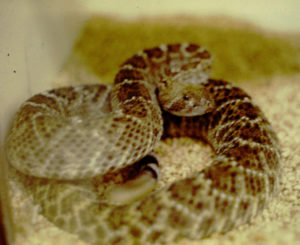
My heart leaped into my throat and began to gallop at a pace which was palpable. I couldn’t see the snake lurking in the grass before me, but it couldn’t have been more than an arm’s length away. The sound was too close, too loud, and too distinct to be otherwise. My mind raced through the possible reactions I should take. Running didn’t seem like a good option; I thought a sudden movement might provoke a strike. Another possibility was mistaking the exact location of the snake and blundering into during a precipitous flight. It seemed the best course of action was to remain still, try to visually locate the snake, and hope that it wasn’t feeling overly aggressive today. All the while, I mentally ran through a catalog of the possible rattlesnake species that I might be confronting. Western diamondback and prairie rattler seemed the two prospects.
While all these thoughts were rapidly presenting themselves, the serpent began to reveal itself. The tuft of grass in which it had hidden began to slowly rise, as though being inflated by some invisible pumping mechanism. Now I could begin to make out the coils of a very large snake (too big for a prairie rattlesnake I thought) emerging from the grass. A background color of brownish-yellow was revealed and upon this was imprinted a series of very dark brown dorsal blotches. They were not really diamond-shaped, more rectangular, and my fear began to subside somewhat. But the rattling sound continued unabated; I was still puzzled. At last the serpent’s head came into view, perched on the end of a wicked looking, rattlesnake-like “ S-loop” at the front of the body. Finally the mystery, at least to the snake’s identity, was revealed. Running from the eye to the angle of the jaw was a quite distinct dark band bordered by a yellowish band above it. The snake’s head was also familiar to me. I experienced an instance of what biologists often refer to as “gestalt”. This is the presence of a mental image, often difficult to describe to a neophyte, which allows one to recognize a given type of organism. There was a certain conformity of head shape and scale pattern which clearly said bullsnake. I wasn’t in a life-threatening situation after all – whew!
The bullsnake lying before was nevertheless an impressive animal. Not many snakes in the United States are larger than a mature bullsnake. The record length for this species is nearly eight and a half feet. Coupled with their size is a propensity to act aggressively when disturbed. I once narrowly avoided being bitten in the face by a grumpy bullsnake that launched a strike from what seemed to be an impossibly distant reach. But the rattling sound being produced by the snake here in my presence continued to intrigue me. It was so nearly identical to the sound of a large
rattlesnake that I could hardly believe it was issuing forth from this individual. It is extremely common for snakes of many species to vibrate their tail when agitated. If this is done against dry leaves or grasses, the sound can be remarkably similar to that of a rattler. However, my bullsnake was not doing that. As I watched it more intently, I noticed that this rattler-like sound seemed to coincide with a very noticeable exhalation of air. Of course many snakes hiss as part of their aposematic display. But this was no hiss; it was a rattlesnake rattle. I continued, with now normal heart rate, down the trap line still pondering how the snake was making this sound.
Later, back in Terre Haute, I delved into the bullsnake’s secret. When snakes hiss they forcefully expel air from their glottis. The glottis is basically the opening into their trachea or windpipe if you will. We have one too of course. Ours lies in the back of our throat. In snakes, the glottis is extended forward to open as a tube on the floor of the mouth just behind the lower, front teeth. This adaptation allows them to breathe while their mouth is stuffed full of a large prey item during the swallowing process (which may take many minutes). I found that, in bullsnakes, there is a flap of soft tissue at the end of the glottis which vibrates back and forth as they expel air from the lung. This flapping imitates the sound of a rattlesnake rattle to an amazing degree. It is easy to see how the evolution of such structure and behavior in the bullsnake would be adaptive. Adaptive is a fancy way biologists have of saying that an evolved characteristic is beneficial to an organism. Predators or grazers which have learned by experience to avoid the dangerous rattlesnake species would certainly be put off by the excellent mimicry of the bullsnake.
Thus it was, once again, that a chance encounter with a denizen of the wild led me down an unexpected yet rewarding learning path. The bullsnake who would be a rattler became not just another coincidental animal meeting, but a guide who opened the door to yet another secret niche lying within the wondrously biodiverse world in which we all live.
Additional Notes Regarding Mimicry:
Mimicry takes many forms within the animal kingdom. The harmless scarlet kingsnake has a color pattern which looks much like that of the dangerously venomous coral snake. Hover flies are easily mistaken for bees by novice observers. Mimicry in which a harmless or edible species resembles a harmful or distasteful one is called Batesian mimicry. The name honors the nineteenth century naturalist Walter Henry Bates. In other cases, such as heliconid butterflies, several bad tasting (to birds) species resemble one another so all achieve a collective protection. This is an example of Muellerian mimicry. Sometimes mimicry can be achieved through structure or color. Technically, this might be better categorized as having cryptic structure or color. For example, certain lepidopteran caterpillars resemble the droppings of birds. Others, should the branch upon which they are climbing be jostled, will suddenly stiffen and rear up at an angle. Thus posed, they look remarkably like the petiole from which a leaf has broken. There are butterflies in the tropics which resemble dead leaves, complete with what appear to be holes formed by the action of fungi. Katydids often bear extraordinary resemblance to living leaves. Walking stick insects look, of course, like the twigs upon which they clamber about. The natural world is replete with examples of mimicry, protective resemblance, camouflaging coloration, and behavioral copycats.
Photos by the author.

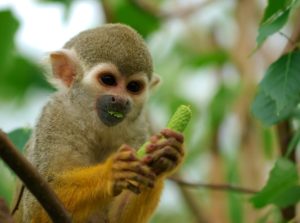 It was a mixed band of squirrel monkeys and saddle-back tamarins that had attracted my attention. Up ahead I could see their swift movements among the branches of a towering Inga tree. The calls of these
It was a mixed band of squirrel monkeys and saddle-back tamarins that had attracted my attention. Up ahead I could see their swift movements among the branches of a towering Inga tree. The calls of these  little primates could easily be mistaken for the vocalizations of birds. In fact, it was their calling that had originally drawn my attention to the tree they were exploring. This tree was located only a few hundred yards from the majestic Amazon River in northeastern Peru. Here the Neotropical rainforest presented a most splendid exhibit of biodiversity. I was walking within a forest which held ten percent of the world’s plant species. Dispersed on and beneath the impressive community of forest giants – kapok, fig, pacay, Brazil nut – lived a multitudinous assemblage of fungi, insects, spiders, frogs, lizards, snakes, birds, and mammals. Stepping along the trail toward the little primates, I squeezed through a rich undergrowth of ginger, irapay and pona palm, philodendron, melastoma, and maranta. Although the comparison is shopworn, it really was akin to walking within a crowded greenhouse. In the background I heard the periodic calls of screaming piha’s. The piercing, exotic whistles of these rather nondescript, grayish brown birds cried out to me – “rainforest, this is tropical rainforest”. (You can hear one at the following link.)
little primates could easily be mistaken for the vocalizations of birds. In fact, it was their calling that had originally drawn my attention to the tree they were exploring. This tree was located only a few hundred yards from the majestic Amazon River in northeastern Peru. Here the Neotropical rainforest presented a most splendid exhibit of biodiversity. I was walking within a forest which held ten percent of the world’s plant species. Dispersed on and beneath the impressive community of forest giants – kapok, fig, pacay, Brazil nut – lived a multitudinous assemblage of fungi, insects, spiders, frogs, lizards, snakes, birds, and mammals. Stepping along the trail toward the little primates, I squeezed through a rich undergrowth of ginger, irapay and pona palm, philodendron, melastoma, and maranta. Although the comparison is shopworn, it really was akin to walking within a crowded greenhouse. In the background I heard the periodic calls of screaming piha’s. The piercing, exotic whistles of these rather nondescript, grayish brown birds cried out to me – “rainforest, this is tropical rainforest”. (You can hear one at the following link.) I listened as a continuous series of high-pitched squeaks, trills, and
I listened as a continuous series of high-pitched squeaks, trills, and 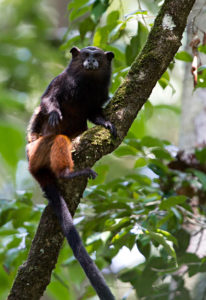 staccato screeches produced by the busy monkeys issued from the trees just ahead of me. Lifting my binoculars to my eyes, I once again scanned ahead and saw that the roving assemblage was much closer now. I could clearly make out individual animals within the primate band. If I could only get a little nearer I would really be able to observe their behavior. Lowering my binoculars, I began to move closer to the little animals. With one foot thus poised in mid-stride, there suddenly came to me a second thought. The how or why of this sudden, unbidden neuronal signal has puzzled me for many years. Whatever the source, there abruptly arose in my mind a delicate warning. Be careful it said. Watch where you step it whispered. Heeding this cautioning counsel without question, I glanced down at the trail. Lying there, directly in the path of my next step, was a snake. My heart made a sudden lunge into a higher gear. This was not just any snake. Resting there at my feet, its head slightly raised from the ground in alertness was a fer-de-lance, considered by many to be the most dangerously venomous snake in the Neotropics.
staccato screeches produced by the busy monkeys issued from the trees just ahead of me. Lifting my binoculars to my eyes, I once again scanned ahead and saw that the roving assemblage was much closer now. I could clearly make out individual animals within the primate band. If I could only get a little nearer I would really be able to observe their behavior. Lowering my binoculars, I began to move closer to the little animals. With one foot thus poised in mid-stride, there suddenly came to me a second thought. The how or why of this sudden, unbidden neuronal signal has puzzled me for many years. Whatever the source, there abruptly arose in my mind a delicate warning. Be careful it said. Watch where you step it whispered. Heeding this cautioning counsel without question, I glanced down at the trail. Lying there, directly in the path of my next step, was a snake. My heart made a sudden lunge into a higher gear. This was not just any snake. Resting there at my feet, its head slightly raised from the ground in alertness was a fer-de-lance, considered by many to be the most dangerously venomous snake in the Neotropics.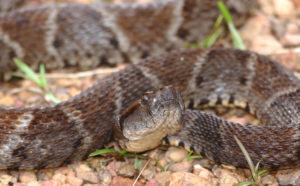

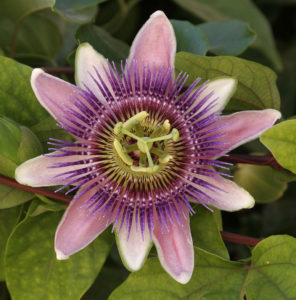 sion flowers, the heliconias, torch
sion flowers, the heliconias, torch 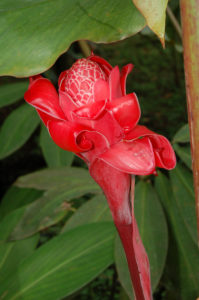 ginger, and the myriad species of orchids. Here at home, I am captivated by the loveliness of spring beauty and Dutchman’s breeches, catalpa and Virginia bluebell, Silphium and blazing star. They all seem to go beyond the bounds of practicality. The rich diversity of colors,
ginger, and the myriad species of orchids. Here at home, I am captivated by the loveliness of spring beauty and Dutchman’s breeches, catalpa and Virginia bluebell, Silphium and blazing star. They all seem to go beyond the bounds of practicality. The rich diversity of colors,  shadings, crenellations, and flamboyancy seem to defy all reason.
shadings, crenellations, and flamboyancy seem to defy all reason.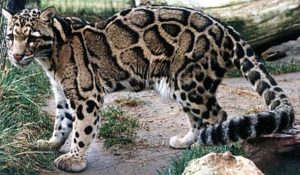 serve as sufficient camouflage within the middle layers of the rainforest. But no, this extraordinary cat is covered in a myriad of blotches of multitudinous shades from white to gray, fawn to black, sand to sepia. Arranged in a bedazzling array of smudges, spots, ovals, oblongs, and squares their coat renders them nearly invisible within their tropical forest home. But I can’t help but perceive that the pattern of their coat goes well beyond the bounds of a super-efficient camouflage. I cannot look at a clouded leopard and not find myself stunned by its absolutely exquisite beauty. I invariably feel a visceral emotion that is totally divorced from my understanding of the biological mechanisms which bring about this beauty. I dare say the feeling is more akin to the sensation I receive when contemplating an impressionist painting or listening to the opening strains of Beethoven’s Violin Concerto in D major.
serve as sufficient camouflage within the middle layers of the rainforest. But no, this extraordinary cat is covered in a myriad of blotches of multitudinous shades from white to gray, fawn to black, sand to sepia. Arranged in a bedazzling array of smudges, spots, ovals, oblongs, and squares their coat renders them nearly invisible within their tropical forest home. But I can’t help but perceive that the pattern of their coat goes well beyond the bounds of a super-efficient camouflage. I cannot look at a clouded leopard and not find myself stunned by its absolutely exquisite beauty. I invariably feel a visceral emotion that is totally divorced from my understanding of the biological mechanisms which bring about this beauty. I dare say the feeling is more akin to the sensation I receive when contemplating an impressionist painting or listening to the opening strains of Beethoven’s Violin Concerto in D major. sheer elegance of form what could surpass the stealthily wading great egret or the striding black-necked stilt? What figures in motion are more graceful than the dynamic soaring of a wandering albatross or the lazy circling of a red-tailed hawk riding upon its invisible donut of air? Should we want to rank the beauty of
sheer elegance of form what could surpass the stealthily wading great egret or the striding black-necked stilt? What figures in motion are more graceful than the dynamic soaring of a wandering albatross or the lazy circling of a red-tailed hawk riding upon its invisible donut of air? Should we want to rank the beauty of 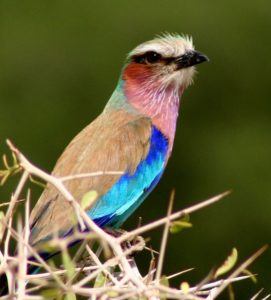 birds based upon their color, we might find that this too is not so simple. The colors and forms exhibited among the Aves seem nearly infinite. How could I hope to choose a winner from among the likes of Tanzania’s lilac-breasted roller, Costa Rica’s resplendent quetzal, our American wood duck, Malaysia’s Argus
birds based upon their color, we might find that this too is not so simple. The colors and forms exhibited among the Aves seem nearly infinite. How could I hope to choose a winner from among the likes of Tanzania’s lilac-breasted roller, Costa Rica’s resplendent quetzal, our American wood duck, Malaysia’s Argus  pheasant, or Peru’s masked trogon? Though I understand the adaptive nature of beak, wing and leg, I still cannot fully fathom why I am compelled to stare at such birds in dumbstruck reverence.
pheasant, or Peru’s masked trogon? Though I understand the adaptive nature of beak, wing and leg, I still cannot fully fathom why I am compelled to stare at such birds in dumbstruck reverence.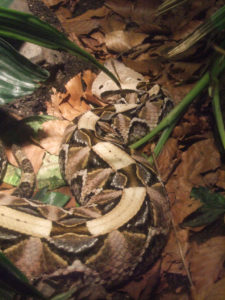 fact that it is an animal of great esthetic beauty. Lying quietly upon a bed of leaves, this serpent becomes virtually invisible. The rich mixture of browns, blacks, fawns, yellows, creams, and whites are arranged in an intricate pattern of blotches, rectangles, and leafy shapes that make it astonishingly difficult to distinguish. Looking upon one of these snakes, I must convince myself that an artist of supreme skill has not surreptitiously sneaked into the reptile house by night and completed a marvelous job of body painting
fact that it is an animal of great esthetic beauty. Lying quietly upon a bed of leaves, this serpent becomes virtually invisible. The rich mixture of browns, blacks, fawns, yellows, creams, and whites are arranged in an intricate pattern of blotches, rectangles, and leafy shapes that make it astonishingly difficult to distinguish. Looking upon one of these snakes, I must convince myself that an artist of supreme skill has not surreptitiously sneaked into the reptile house by night and completed a marvelous job of body painting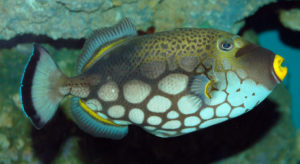 most beautiful contest. Rainbow trout, rainbow darter, clown triggerfish, dolphinfish, Achilles tang, lion fish, angel fish, and Moorish idol. How could I
most beautiful contest. Rainbow trout, rainbow darter, clown triggerfish, dolphinfish, Achilles tang, lion fish, angel fish, and Moorish idol. How could I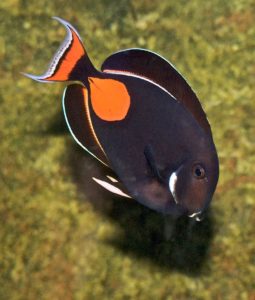 choose from this kaleidoscopic of blues, greens, yellows, oranges, reds, and golds? Scientifically, rationally we know that the color patterns of these fishes may serve to camouflage, to distinguish sexes, to identify a species. But do their
choose from this kaleidoscopic of blues, greens, yellows, oranges, reds, and golds? Scientifically, rationally we know that the color patterns of these fishes may serve to camouflage, to distinguish sexes, to identify a species. But do their 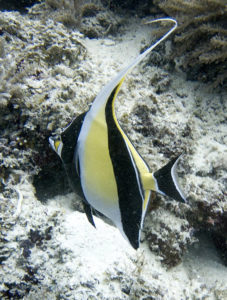 colors really have to be so varied, their forms so diverse, their hues so subtle, and their shades so delicate? Something tells me they do not.
colors really have to be so varied, their forms so diverse, their hues so subtle, and their shades so delicate? Something tells me they do not.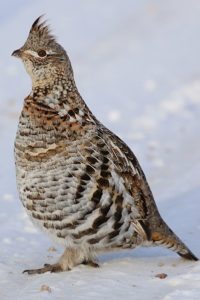 subtract the grouse and the whole thing is dead.” The essence responsible for the unquantifiable quality of the north woods Leopold called the noumenon of material things. It stands in opposition to a phenomenon, something that is concrete and subject to empirical study. Could it be that complexity, diversity, and beauty are reflections of the noumenon that generates the sense of awe we often experience in the natural world? Is it this noumenon, this unquantifiable presence that compel s us to experience with an emotion akin to religious awe a soaring flock of cranes, a flowering prairie, the north woods?
subtract the grouse and the whole thing is dead.” The essence responsible for the unquantifiable quality of the north woods Leopold called the noumenon of material things. It stands in opposition to a phenomenon, something that is concrete and subject to empirical study. Could it be that complexity, diversity, and beauty are reflections of the noumenon that generates the sense of awe we often experience in the natural world? Is it this noumenon, this unquantifiable presence that compel s us to experience with an emotion akin to religious awe a soaring flock of cranes, a flowering prairie, the north woods? Van Horn’s view. Within that essay lies this passage. “I heard of a boy once who was brought up an atheist. He changed his mind when he saw that there were a hundred-odd species of warblers, each bedecked like to the rainbow. . . No fortuitous concourse of elements working blindly through any number of millions of years could account for why warblers are so beautiful. No mechanistic theory . . . has ever quite answered for the colors of the cerulean warbler, or the vespers of the wood thrush, or the swansong, or goose music”. Leopold ended his ruminations upon the boy who came to believe with these words. “There are yet many boys to be born who, like Isaiah, may see, and know and consider, and understand together, that the hand of the Lord hath done this.”
Van Horn’s view. Within that essay lies this passage. “I heard of a boy once who was brought up an atheist. He changed his mind when he saw that there were a hundred-odd species of warblers, each bedecked like to the rainbow. . . No fortuitous concourse of elements working blindly through any number of millions of years could account for why warblers are so beautiful. No mechanistic theory . . . has ever quite answered for the colors of the cerulean warbler, or the vespers of the wood thrush, or the swansong, or goose music”. Leopold ended his ruminations upon the boy who came to believe with these words. “There are yet many boys to be born who, like Isaiah, may see, and know and consider, and understand together, that the hand of the Lord hath done this.”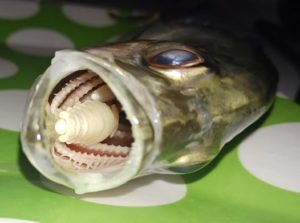 atrophy until only a stump remains. The isopod remains attached to the muscles of this stub and begins to actually function as the fish host’s tongue. The tongue-eating isopod, how macabre is that? I’m sure glad it doesn’t have a taste for humans. It would put a whole new spin on accidentally getting a mouthful of seawater while swimming wouldn’t it?
atrophy until only a stump remains. The isopod remains attached to the muscles of this stub and begins to actually function as the fish host’s tongue. The tongue-eating isopod, how macabre is that? I’m sure glad it doesn’t have a taste for humans. It would put a whole new spin on accidentally getting a mouthful of seawater while swimming wouldn’t it? enlargement of body regions can be so extreme as to inhibit mobility. Deformity of this sort requires repeated infection with the microfilarial worm Wuchereria over a period of years. Fortunately, although nearly fifteen percent of the human population lives in areas where elephantiasis is endemic, such extreme cases are rare. Anecdotally, during the three years I lived in Southeast Asia, I actually saw only one case of this disease and the person afflicted exhibited only a slight swelling of one leg.
enlargement of body regions can be so extreme as to inhibit mobility. Deformity of this sort requires repeated infection with the microfilarial worm Wuchereria over a period of years. Fortunately, although nearly fifteen percent of the human population lives in areas where elephantiasis is endemic, such extreme cases are rare. Anecdotally, during the three years I lived in Southeast Asia, I actually saw only one case of this disease and the person afflicted exhibited only a slight swelling of one leg.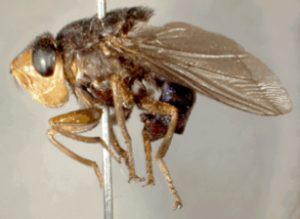 blowfly like we might see buzzing around a road-killed opossum here in Indiana. If that was the habit of Dermatobia as well, we might rest easily in its presence. But, as you can guess, this botfly isn’t nearly as innocuous. Like other flies, this species goes through an elaborate reproductive metamorphosis in which it proceeds, stepwise, from egg to larva to pupa to adult. The larva, again as in other members of the fly Order, is a maggot. But, the human botfly maggot is of rather impressive countenance. The larva is nearly an inch in length, stout in girth, armed with ringlets of stiff, spiny bristles, and has a rather robust pair of jaws.
blowfly like we might see buzzing around a road-killed opossum here in Indiana. If that was the habit of Dermatobia as well, we might rest easily in its presence. But, as you can guess, this botfly isn’t nearly as innocuous. Like other flies, this species goes through an elaborate reproductive metamorphosis in which it proceeds, stepwise, from egg to larva to pupa to adult. The larva, again as in other members of the fly Order, is a maggot. But, the human botfly maggot is of rather impressive countenance. The larva is nearly an inch in length, stout in girth, armed with ringlets of stiff, spiny bristles, and has a rather robust pair of jaws. were to rid themselves of their grisly cargo. I could also not avoid the realization that this fly would just as opportunely infect me in the same manner. One might wonder how a fly as large as this could so furtively deposit its egg on either a howler monkey or a human. Surely it would be easy to hear its buzzing approach and shoo it away. But here again the amazing deviousness, in regards to completing a life cycle, which has evolved in parasites comes into play. The human botfly uses a less detectable emissary to deliver its egg payload, most often a mosquito.
were to rid themselves of their grisly cargo. I could also not avoid the realization that this fly would just as opportunely infect me in the same manner. One might wonder how a fly as large as this could so furtively deposit its egg on either a howler monkey or a human. Surely it would be easy to hear its buzzing approach and shoo it away. But here again the amazing deviousness, in regards to completing a life cycle, which has evolved in parasites comes into play. The human botfly uses a less detectable emissary to deliver its egg payload, most often a mosquito. This is assuming, of course, that the physician is somewhat familiar with tropical diseases and recognizes what is going on; this is not always a given.
This is assuming, of course, that the physician is somewhat familiar with tropical diseases and recognizes what is going on; this is not always a given.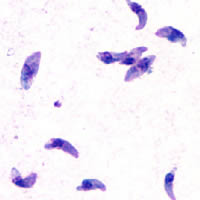
 common in a variety of mammals. These include cats, rodents, pigs, and humans. By some estimates, nearly thirty percent of the world’s human population is infected with Toxoplasma. Normally the protozoan, after causing initial flu-like symptoms, resides in the human body without further affect – or so it was thought.
common in a variety of mammals. These include cats, rodents, pigs, and humans. By some estimates, nearly thirty percent of the world’s human population is infected with Toxoplasma. Normally the protozoan, after causing initial flu-like symptoms, resides in the human body without further affect – or so it was thought.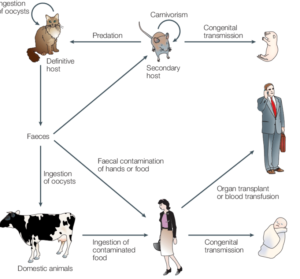
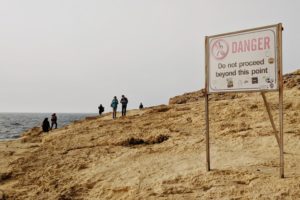 motorists he met with total indifference. Furthermore, he openly criticized the ruling Communist Party, a most dangerous endeavor at that time. Doing research in a war torn area of Turkey, he was surprised that his reaction to nearby gunfire was complete lack of distress and absence of any instinct to take cover. All of these behaviors bore an uncanny resemblance to the daredevil antics of a rat with toxoplasmosis.
motorists he met with total indifference. Furthermore, he openly criticized the ruling Communist Party, a most dangerous endeavor at that time. Doing research in a war torn area of Turkey, he was surprised that his reaction to nearby gunfire was complete lack of distress and absence of any instinct to take cover. All of these behaviors bore an uncanny resemblance to the daredevil antics of a rat with toxoplasmosis.
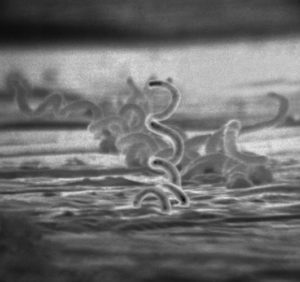 most of her coworkers, she had acquired syphilis during this time. As you know, this is a highly contagious, sexually transmitted disease caused by a bacterium named Treponema pallidum. This bacterium is a type of spirochete, so-called because of its helically spiraled shape.
most of her coworkers, she had acquired syphilis during this time. As you know, this is a highly contagious, sexually transmitted disease caused by a bacterium named Treponema pallidum. This bacterium is a type of spirochete, so-called because of its helically spiraled shape.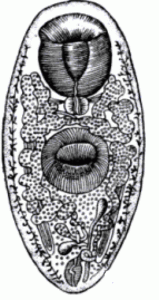 Leucochloridium parasitizes birds. The big problem faced by Leucochloridium, and parasites in general, is how to get from one host to another. Endoparasites are highly and specifically adapted for surviving in the warm, dark, nutrient rich innards of their host. They are not built to function in what for them is the hostile outer world we humans inhabit. Here the atmosphere is highly oxygenated, there is intense sunlight, and ambient temperatures are highly variable. Yet, to continue their species, they must find a way to insinuate their adult progeny into the internal organs of another host.
Leucochloridium parasitizes birds. The big problem faced by Leucochloridium, and parasites in general, is how to get from one host to another. Endoparasites are highly and specifically adapted for surviving in the warm, dark, nutrient rich innards of their host. They are not built to function in what for them is the hostile outer world we humans inhabit. Here the atmosphere is highly oxygenated, there is intense sunlight, and ambient temperatures are highly variable. Yet, to continue their species, they must find a way to insinuate their adult progeny into the internal organs of another host.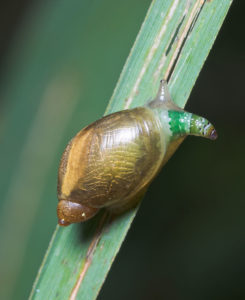 banded, animated appearance bears a remarkable resemblance to a caterpillar. Of course caterpillars are a favorite food of many bird species. And remember, these puffed-up tentacles are packed with fluke larvae very much needing to get into a bird.
banded, animated appearance bears a remarkable resemblance to a caterpillar. Of course caterpillars are a favorite food of many bird species. And remember, these puffed-up tentacles are packed with fluke larvae very much needing to get into a bird.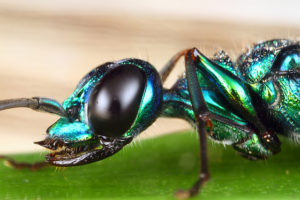 than an inch) wasp with a beautiful metallic greenish-bluish body color. And, it does indeed parasitize cockroaches. As you might guess, it is the manner in which it does so that is dumbfounding.
than an inch) wasp with a beautiful metallic greenish-bluish body color. And, it does indeed parasitize cockroaches. As you might guess, it is the manner in which it does so that is dumbfounding.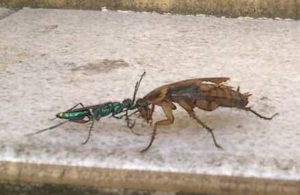 antennae with its jaws, the wasp leads its host to a previously prepared burrow in the ground. Like a well-trained dog on a lead, the cockroach obediently allows itself to be ushered, by the wasp, down into its own tomb.
antennae with its jaws, the wasp leads its host to a previously prepared burrow in the ground. Like a well-trained dog on a lead, the cockroach obediently allows itself to be ushered, by the wasp, down into its own tomb.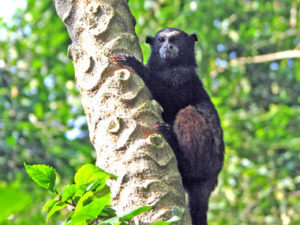 Walking within the tropical rainforest of the Peruvian Amazon is always an adventure. One never quite knows what to expect next. It could be a hitherto un-encountered monkey species, an important medicinal plant, a spectacularly colored bird, or a Yagua hunter moving stealthily along the path blowpipe in hand. On this occasion, the encounter involved an insect and it opened a window into an often hidden aspect of tropical rainforest biology both fascinating and disturbing.
Walking within the tropical rainforest of the Peruvian Amazon is always an adventure. One never quite knows what to expect next. It could be a hitherto un-encountered monkey species, an important medicinal plant, a spectacularly colored bird, or a Yagua hunter moving stealthily along the path blowpipe in hand. On this occasion, the encounter involved an insect and it opened a window into an often hidden aspect of tropical rainforest biology both fascinating and disturbing.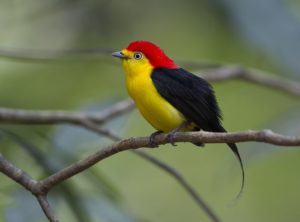 birds, a stunning little wire-tailed manakin – a gem of the rainforest not to mention one of its most accomplished dancers. As we continued along the trail, my eyes wandered over the surrounding vegetation. On the lookout for any movement, I also scanned for the quiet presence of eyelash viper, a species prone to lie about on low vegetation.
birds, a stunning little wire-tailed manakin – a gem of the rainforest not to mention one of its most accomplished dancers. As we continued along the trail, my eyes wandered over the surrounding vegetation. On the lookout for any movement, I also scanned for the quiet presence of eyelash viper, a species prone to lie about on low vegetation. 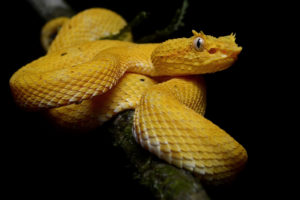 This habit made it a good idea to always look ahead and be aware of where one placed arms, legs, and torso. As I glanced to my left, I noticed a liana creeping from the ground and ascending at a shallow angle up into a nearby tree. Perched upon this liana was a small insect. But what a strange little insect it was. Protruding from its body was what I took to be a pair of exceedingly long antennae. But something didn’t seem quite right; the antennae seemed greatly out of proportion to the insect’s size. Stepping closer, I recognized the insect as a snout beetle. Curculionids are
This habit made it a good idea to always look ahead and be aware of where one placed arms, legs, and torso. As I glanced to my left, I noticed a liana creeping from the ground and ascending at a shallow angle up into a nearby tree. Perched upon this liana was a small insect. But what a strange little insect it was. Protruding from its body was what I took to be a pair of exceedingly long antennae. But something didn’t seem quite right; the antennae seemed greatly out of proportion to the insect’s size. Stepping closer, I recognized the insect as a snout beetle. Curculionids are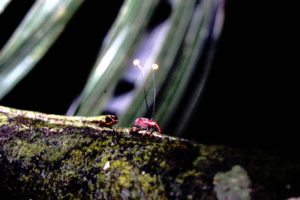
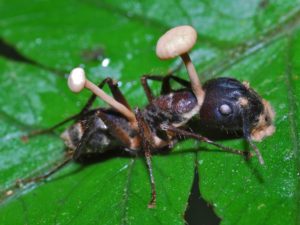 behaviors. Ants infected in such a way may not just climb to a precise height about the ground. They are also induced by the fungal parasite to clamp their jaws onto a stem or leaf petiole with great force. Thus fastened to its perch the ant, after its death, is less likely to fall back to the forest floor before the fungi’s spores are released into the air. Based upon fossil evidence, it appears that this fungus-insect relationship may have evolved several tens of millions of years ago. As this scenario played through my mind, I reflected back to a comment I once heard made by a tropical rainforest biologist. Referring to this type of fungi’s devious biochemical mind control of the host he said, “. . . and we refer to the fungi as a lower form of life?”
behaviors. Ants infected in such a way may not just climb to a precise height about the ground. They are also induced by the fungal parasite to clamp their jaws onto a stem or leaf petiole with great force. Thus fastened to its perch the ant, after its death, is less likely to fall back to the forest floor before the fungi’s spores are released into the air. Based upon fossil evidence, it appears that this fungus-insect relationship may have evolved several tens of millions of years ago. As this scenario played through my mind, I reflected back to a comment I once heard made by a tropical rainforest biologist. Referring to this type of fungi’s devious biochemical mind control of the host he said, “. . . and we refer to the fungi as a lower form of life?”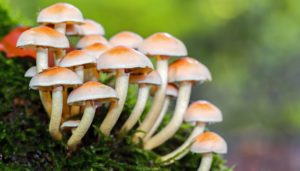 Although they now reside within their own taxonomic kingdom, several generations of biologists once thought of fungi as odd members of the plant kingdom. Fungi lack the indicators of complexity we humans hold in high esteem such as mobility, a central nervous system, and some degree of intelligence. In light of this, the ability of an organism such as Cordyceps to invade an animal and take over control of its mental faculties is downright astounding – and scary. Lest you think that Cordyceps is unique in its uncanny ability to turn its host into a virtual zombie, stay tuned. The Stealth Attack Part 2 will be coming soon.
Although they now reside within their own taxonomic kingdom, several generations of biologists once thought of fungi as odd members of the plant kingdom. Fungi lack the indicators of complexity we humans hold in high esteem such as mobility, a central nervous system, and some degree of intelligence. In light of this, the ability of an organism such as Cordyceps to invade an animal and take over control of its mental faculties is downright astounding – and scary. Lest you think that Cordyceps is unique in its uncanny ability to turn its host into a virtual zombie, stay tuned. The Stealth Attack Part 2 will be coming soon.

 communities in this area have descriptive names such as Prairie Creek, Prairieton, Indian Prairie, or Shaker Prairie. This morning, at various spots along my road, I am greeted by big bluestem, little bluestem, cup plant, tall goldenrod, common milkweed, Indian grass, and butterfly weed. All these represent remnants of the fingers of tallgrass prairie which probed the vacant spots along the western flanks of North America’s immense, eastern deciduous forest. It is impossible for me to consider these plants and not have my mind rush backwards as though I have exerted a forceful pull on the operative lever of H.G. Well’s time machine. I try with all my might to picture a sea of these plants, and many
communities in this area have descriptive names such as Prairie Creek, Prairieton, Indian Prairie, or Shaker Prairie. This morning, at various spots along my road, I am greeted by big bluestem, little bluestem, cup plant, tall goldenrod, common milkweed, Indian grass, and butterfly weed. All these represent remnants of the fingers of tallgrass prairie which probed the vacant spots along the western flanks of North America’s immense, eastern deciduous forest. It is impossible for me to consider these plants and not have my mind rush backwards as though I have exerted a forceful pull on the operative lever of H.G. Well’s time machine. I try with all my might to picture a sea of these plants, and many 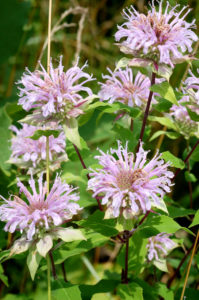 other species of course, stretching away to the horizon. What a vista it must have been; the bluestem, tall as a man on horseback, rippling in the wind and interspersed with inestimable acres of purple coneflower, leadplant, blazing star, rattlesnake
other species of course, stretching away to the horizon. What a vista it must have been; the bluestem, tall as a man on horseback, rippling in the wind and interspersed with inestimable acres of purple coneflower, leadplant, blazing star, rattlesnake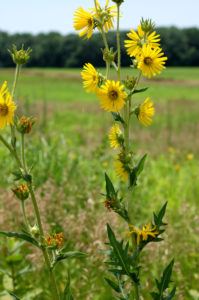 master, grama grass, cutleaf silphium, partridge pea, queen of the prairie, and rosinweed! A herd of American bison, numbering in multiples of a thousand, can be seen slowly cruising among the prairie plants and industriously converting sunlight energy into muscle, sinew, and bone. It is a grand scene that plays in my mind. Admittedly, my vision is tinged with melancholy as I recall that over ninety percent of North America’s tallgrass prairie is now gone. I am reminded of the words of the great conservationist Aldo Leopold. “What a thousand acres of Silphiums looked like when they tickled the bellies of the buffalo is a question never again to be answered, and perhaps not even asked.”
master, grama grass, cutleaf silphium, partridge pea, queen of the prairie, and rosinweed! A herd of American bison, numbering in multiples of a thousand, can be seen slowly cruising among the prairie plants and industriously converting sunlight energy into muscle, sinew, and bone. It is a grand scene that plays in my mind. Admittedly, my vision is tinged with melancholy as I recall that over ninety percent of North America’s tallgrass prairie is now gone. I am reminded of the words of the great conservationist Aldo Leopold. “What a thousand acres of Silphiums looked like when they tickled the bellies of the buffalo is a question never again to be answered, and perhaps not even asked.” 
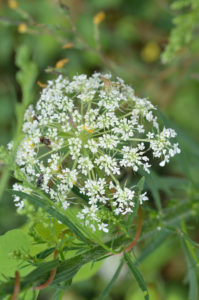 than the scoundrels mentioned above. In fact, I find them downright attractive. Queen Anne’s lace is a lovely, white-flowered native of Europe and a relative of the domestic carrot. There are also dandelions to be seen here and there. Another European native, this plant is also a common member of that diverse assemblage of flora that passes for my lawn. Many berate the dandelion for its audacity in marring their well-manicured yard. But I welcome it and sometimes take advantage of it in the spring when, upon experiencing a dearth of morels, I pick the blossoms and fry them in egg, flour, and butter. Thus prepared they are quite delicious. This morning I see chicory too; its vibrant blue flowers stand out like little neon signs along the road. Another Eurasian import, chicory has a long history of use by humans both as a food and as a coffee substitute.
than the scoundrels mentioned above. In fact, I find them downright attractive. Queen Anne’s lace is a lovely, white-flowered native of Europe and a relative of the domestic carrot. There are also dandelions to be seen here and there. Another European native, this plant is also a common member of that diverse assemblage of flora that passes for my lawn. Many berate the dandelion for its audacity in marring their well-manicured yard. But I welcome it and sometimes take advantage of it in the spring when, upon experiencing a dearth of morels, I pick the blossoms and fry them in egg, flour, and butter. Thus prepared they are quite delicious. This morning I see chicory too; its vibrant blue flowers stand out like little neon signs along the road. Another Eurasian import, chicory has a long history of use by humans both as a food and as a coffee substitute. taking advantage of the wet soil there. This plant has long intrigued me for the eclectic uses it offered generations of native peoples. The long, durable leaves could be woven into mats for floor or wall. The roots are quite edible. They remind me somewhat of cabbage. I’ve been told that cattail pollen has served as a substitute for flour in making pancakes. It is also a plant much favored for nesting by one of my favorite birds, the red-winged blackbird. Sadly, this plant has been replaced over much of its range here in Sullivan County by a non-native subspecies of Phragmites. This very tall invasive grass grows in dense stands, blocks shorelines, forms virtually impenetrable stands, and in my eyes has none of the virtues of the cattail.
taking advantage of the wet soil there. This plant has long intrigued me for the eclectic uses it offered generations of native peoples. The long, durable leaves could be woven into mats for floor or wall. The roots are quite edible. They remind me somewhat of cabbage. I’ve been told that cattail pollen has served as a substitute for flour in making pancakes. It is also a plant much favored for nesting by one of my favorite birds, the red-winged blackbird. Sadly, this plant has been replaced over much of its range here in Sullivan County by a non-native subspecies of Phragmites. This very tall invasive grass grows in dense stands, blocks shorelines, forms virtually impenetrable stands, and in my eyes has none of the virtues of the cattail.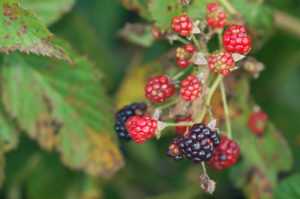 me of the labor intensive work required to collect them. One can expect badly scratched hands as a souvenir of gathering them as well. Here is a life lesson perhaps. Something as coveted as a blackberry cobbler does not come without effort.
me of the labor intensive work required to collect them. One can expect badly scratched hands as a souvenir of gathering them as well. Here is a life lesson perhaps. Something as coveted as a blackberry cobbler does not come without effort.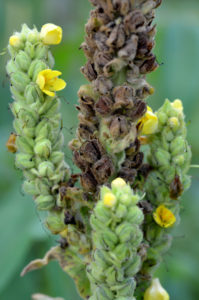 ound the long, erect flower stems to be good substitutes for lances and yes, of course we threw them at each other. The plant having been here for over two centuries, some Native American tribes used mullein for medicinal purposes. Smoking the dried leaves was said to treat respiratory conditions such as bronchitis.
ound the long, erect flower stems to be good substitutes for lances and yes, of course we threw them at each other. The plant having been here for over two centuries, some Native American tribes used mullein for medicinal purposes. Smoking the dried leaves was said to treat respiratory conditions such as bronchitis.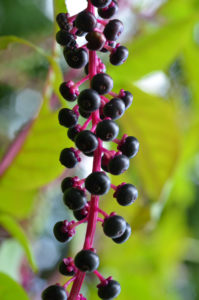 between boilings is recommended. Several species of birds feed on pokeweed berries and are unaffected by its poisonous components phytolaccine, phytolaccatoxin, and phytolaccigenin.
between boilings is recommended. Several species of birds feed on pokeweed berries and are unaffected by its poisonous components phytolaccine, phytolaccatoxin, and phytolaccigenin.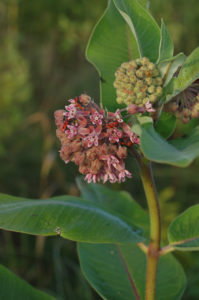 tempted to stop and help disperse the seeds. There was a captivating beauty in seeing the small, flattened, black seeds whisked into the air by a stiff breeze. Riding the air currents, their cotton-like fluff caught the wind and parachuted the seeds to great heights and far distances. I stood mesmerized by the spectacle of these little packets of starch and DNA being launched into the waiting landscape. What was their fate I wondered? How many would fall upon fertile ground? How many would find the inhospitable world of tarmac, concrete, or water? Away from my road, these plants have been significantly displaced by farming and herbicide application. This is detrimental to the monarch butterfly whose population has undergone drastic decline in the past twenty years or so. Their larvae feed exclusively upon milkweed leaves and incorporate the plant’s toxins into their tissues. Thus they become foul tasting and poisonous to predators. I see no monarchs on today’s walk.
tempted to stop and help disperse the seeds. There was a captivating beauty in seeing the small, flattened, black seeds whisked into the air by a stiff breeze. Riding the air currents, their cotton-like fluff caught the wind and parachuted the seeds to great heights and far distances. I stood mesmerized by the spectacle of these little packets of starch and DNA being launched into the waiting landscape. What was their fate I wondered? How many would fall upon fertile ground? How many would find the inhospitable world of tarmac, concrete, or water? Away from my road, these plants have been significantly displaced by farming and herbicide application. This is detrimental to the monarch butterfly whose population has undergone drastic decline in the past twenty years or so. Their larvae feed exclusively upon milkweed leaves and incorporate the plant’s toxins into their tissues. Thus they become foul tasting and poisonous to predators. I see no monarchs on today’s walk.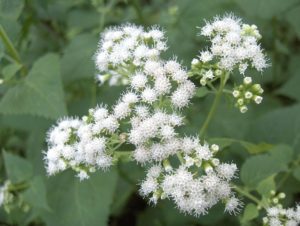 meat and milk of cattle which graze the plant. The result is a disease called milk sickness. This disorder was common in the 1800’s and caused the death of many people in the Midwest. When reading about this plant, the victim most famously mentioned is Abraham Lincoln’s mother Nancy Hanks Lincoln. She died from milk sickness in 1818. Eventually the connection between white snakeroot and the disease came to be understood, apparently as the result of herbal lore passed from a Shawnee woman. The flowers of the plant are attractive and my wife often uses them in fresh-cut bouquets. The fluffy, white blossoms arranged in flat-headed panicles upon the upper stems appear quite innocuous. A curious but uninformed observer would never guess the tragic history of this plant’s relationship with our pioneer ancestors.
meat and milk of cattle which graze the plant. The result is a disease called milk sickness. This disorder was common in the 1800’s and caused the death of many people in the Midwest. When reading about this plant, the victim most famously mentioned is Abraham Lincoln’s mother Nancy Hanks Lincoln. She died from milk sickness in 1818. Eventually the connection between white snakeroot and the disease came to be understood, apparently as the result of herbal lore passed from a Shawnee woman. The flowers of the plant are attractive and my wife often uses them in fresh-cut bouquets. The fluffy, white blossoms arranged in flat-headed panicles upon the upper stems appear quite innocuous. A curious but uninformed observer would never guess the tragic history of this plant’s relationship with our pioneer ancestors.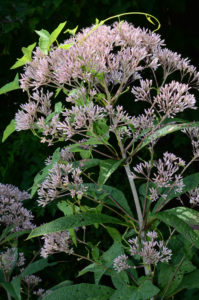 used for any plant that is growing where a human doesn’t want it. Marion Jackson in his The Natural Heritage of Indiana quotes R.W. Emerson’s definition of a weed. I like this one better. “What is a weed? A plant whose virtues have not yet been discovered.” Joe-Pye is a perfect example. Seen along the roadside from an automobile whizzing along at a mile a minute one might indeed be inclined to remark, “Look at that pretty weed.” But gardeners know better. Joe-Pye weed is virtuous as an ornamental plant. Its height and lush, umbrella-shaped, mauve flowers make it stand out as a bold addition to a garden or landscaping project. Furthermore, the very name of the plant alludes to its reputed virtues as a medicinal plant. Legend tells us that Joe Pye was the English name taken by a Native American healer who demonstrated the medicinal properties of the plant to settlers in New England. Teas made from Joe-Pye weed were said to be useful in treating everything from typhoid to rheumatism to impotence. Another name for the plant (gravel-root) was derived from its purported effect in eliminating kidney and gall bladder stones. Are there chemicals in this plant that act as genuine wonder drugs? Although many of our modern drugs are derived from plants, I know of no scientific evidence confirming the efficacy of Joe-Pye weed. Still, as I take leave of this beautiful plant, I can’t help but wonder. Could it be that the Native Americans, with their intimate connection with the natural world, knew something we have yet to fully elucidate and appreciate?
used for any plant that is growing where a human doesn’t want it. Marion Jackson in his The Natural Heritage of Indiana quotes R.W. Emerson’s definition of a weed. I like this one better. “What is a weed? A plant whose virtues have not yet been discovered.” Joe-Pye is a perfect example. Seen along the roadside from an automobile whizzing along at a mile a minute one might indeed be inclined to remark, “Look at that pretty weed.” But gardeners know better. Joe-Pye weed is virtuous as an ornamental plant. Its height and lush, umbrella-shaped, mauve flowers make it stand out as a bold addition to a garden or landscaping project. Furthermore, the very name of the plant alludes to its reputed virtues as a medicinal plant. Legend tells us that Joe Pye was the English name taken by a Native American healer who demonstrated the medicinal properties of the plant to settlers in New England. Teas made from Joe-Pye weed were said to be useful in treating everything from typhoid to rheumatism to impotence. Another name for the plant (gravel-root) was derived from its purported effect in eliminating kidney and gall bladder stones. Are there chemicals in this plant that act as genuine wonder drugs? Although many of our modern drugs are derived from plants, I know of no scientific evidence confirming the efficacy of Joe-Pye weed. Still, as I take leave of this beautiful plant, I can’t help but wonder. Could it be that the Native Americans, with their intimate connection with the natural world, knew something we have yet to fully elucidate and appreciate?
 The boat’s crew made our trip a delightful bundle of exploration, learning, and pure enjoyment. The amiable Captain Mikey delivered his instructions and bits of information with splendidly dry wit and charm. I suspect he would have a good chance of success in a second career as a standup comic. Lucas and Griffin were helpful with equipment fitting and use and hovered over us like protective parents. Snorkel guide Molly gave us an informative introduction to the biology of manta rays and the need for their protection. As I listened to her, I reflected upon the fact that virtually every charismatic animal I learn about these days seems to be under assault.
The boat’s crew made our trip a delightful bundle of exploration, learning, and pure enjoyment. The amiable Captain Mikey delivered his instructions and bits of information with splendidly dry wit and charm. I suspect he would have a good chance of success in a second career as a standup comic. Lucas and Griffin were helpful with equipment fitting and use and hovered over us like protective parents. Snorkel guide Molly gave us an informative introduction to the biology of manta rays and the need for their protection. As I listened to her, I reflected upon the fact that virtually every charismatic animal I learn about these days seems to be under assault. Although there is apparently no historical usage of these structures in traditional Chinese medicine (nor any scientific evidence of their efficacy), the belief has arisen that manta ray gills may provide relief for everything from acne to cancer. Ninety-nine percent of the gill raker trade is centered in Guanzhou, China. The conservation organization SharkSavers reports that sixty-one thousand kilograms (sixty-seven tons) of manta gill material worth US $11 000 000 has been traded there yearly. Such tonnage represents the death of some ninety-seven thousand manta (and devil) rays.
Although there is apparently no historical usage of these structures in traditional Chinese medicine (nor any scientific evidence of their efficacy), the belief has arisen that manta ray gills may provide relief for everything from acne to cancer. Ninety-nine percent of the gill raker trade is centered in Guanzhou, China. The conservation organization SharkSavers reports that sixty-one thousand kilograms (sixty-seven tons) of manta gill material worth US $11 000 000 has been traded there yearly. Such tonnage represents the death of some ninety-seven thousand manta (and devil) rays. There may be hope for the manta ray. It has been noted that sales of gill rakers in Guangzhou were 60.5 tons in 2011 and 120.5 tons in 2015 with a subsequent decline due to conservation campaigns and changes in government policies.
There may be hope for the manta ray. It has been noted that sales of gill rakers in Guangzhou were 60.5 tons in 2011 and 120.5 tons in 2015 with a subsequent decline due to conservation campaigns and changes in government policies.
 The waters of the Pacific were a lovely deep blue when we began. Slowly they morphed into inky blackness as the sun at last disappeared below the far horizon. Snorkeling with the manta rays was a night mission.
The waters of the Pacific were a lovely deep blue when we began. Slowly they morphed into inky blackness as the sun at last disappeared below the far horizon. Snorkeling with the manta rays was a night mission.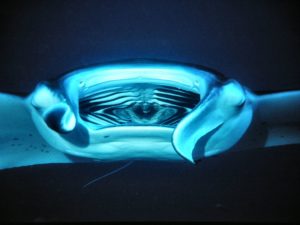 This enormous mouth was propelled upward by the movements of the ray’s wings (pectoral fins) which spanned over six feet. Surging upward it came toward our float; I braced for what seemed an unavoidable impact. But, at the last second, the manta performed a stunningly precise loop within inches of our faces. This maneuver revealed its brilliant white belly which was etched by distinctive black blotches. These “fingerprints” allow identification of individual rays. Downward the ray now plunged into the pillar of plankton. At the bottom another perfect loop was executed and again the ray ascended toward us like some incoming cartilaginous missile. It was quite obvious that the six hundred pound ray was exquisitely aware of its surroundings, the location of its food source, and the curious onlookers looming above it. Mantas have the largest brain to body mass ratio of any fish and studies suggest that they possess self-awareness. How could it not be totally aware of its environment? As I watched the acrobatics of the ray which was soon joined by a comrade, adjectives tumbled from my unconscious. Graceful, powerful, agile, nimble, beautiful – all most appropriate but so exceptionally inadequate in the presence of this astounding creature.
This enormous mouth was propelled upward by the movements of the ray’s wings (pectoral fins) which spanned over six feet. Surging upward it came toward our float; I braced for what seemed an unavoidable impact. But, at the last second, the manta performed a stunningly precise loop within inches of our faces. This maneuver revealed its brilliant white belly which was etched by distinctive black blotches. These “fingerprints” allow identification of individual rays. Downward the ray now plunged into the pillar of plankton. At the bottom another perfect loop was executed and again the ray ascended toward us like some incoming cartilaginous missile. It was quite obvious that the six hundred pound ray was exquisitely aware of its surroundings, the location of its food source, and the curious onlookers looming above it. Mantas have the largest brain to body mass ratio of any fish and studies suggest that they possess self-awareness. How could it not be totally aware of its environment? As I watched the acrobatics of the ray which was soon joined by a comrade, adjectives tumbled from my unconscious. Graceful, powerful, agile, nimble, beautiful – all most appropriate but so exceptionally inadequate in the presence of this astounding creature.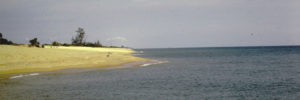
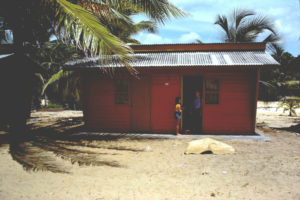
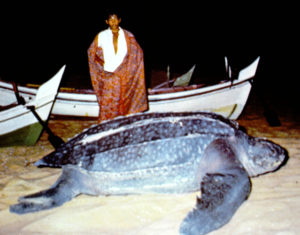
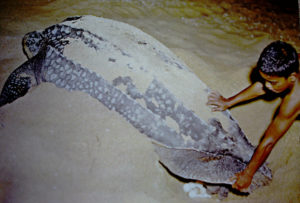

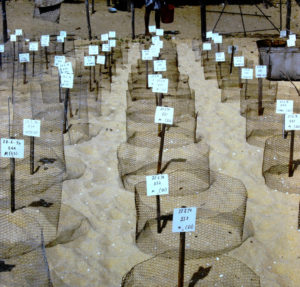
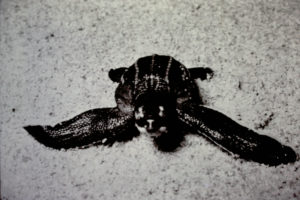
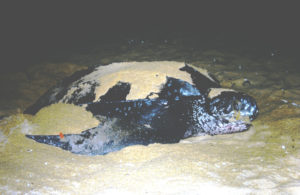
 rainforest as though a phalanx of bulldozers had passed over. Equally shocking was their ability to quickly devour an inattentive human like so much spilled sugar. Many years later, I was to gain a more realistic knowledge of army ant behavior but nevertheless still find them fascinating.
rainforest as though a phalanx of bulldozers had passed over. Equally shocking was their ability to quickly devour an inattentive human like so much spilled sugar. Many years later, I was to gain a more realistic knowledge of army ant behavior but nevertheless still find them fascinating.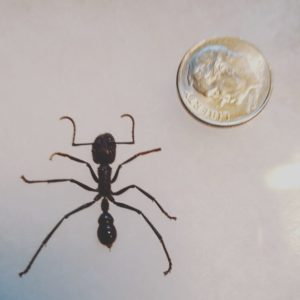 three times that size. Coal black with a wicked looking set of stout mandibles, it was the first ant I had ever encountered that fairly screamed – don’t touch me! Paraponeura also packs a mighty wallop in the form of a venom injecting stinger at the tip of its abdomen. The intense pain of this wound persists for many hours. It is a pain said to be comparable to being shot, thus the name bullet ant. An entomologist by the name of Justin Schmidt has actually developed a scale for ranking the pain caused by the stings of various hymenopterans (ants, bee, and wasps). One must admire both his dedication to science and gallantry in developing his index of pain. Admittedly the degree to which pain is felt is somewhat subjective and, for those allergic to insect stings, any encounter can be life threatening. But be this as it may, Schmidt ranks the bullet ant numero uno when it comes to discomfort. On his pain scale of 1-4, it is a 4+. Schmidt described the sting of a single bullet ant as pain which was “pure, intense, brilliant, agonizing, and long lasting”. He reckoned the intensity of the sting to be several dozen times that of a common paper wasp.
three times that size. Coal black with a wicked looking set of stout mandibles, it was the first ant I had ever encountered that fairly screamed – don’t touch me! Paraponeura also packs a mighty wallop in the form of a venom injecting stinger at the tip of its abdomen. The intense pain of this wound persists for many hours. It is a pain said to be comparable to being shot, thus the name bullet ant. An entomologist by the name of Justin Schmidt has actually developed a scale for ranking the pain caused by the stings of various hymenopterans (ants, bee, and wasps). One must admire both his dedication to science and gallantry in developing his index of pain. Admittedly the degree to which pain is felt is somewhat subjective and, for those allergic to insect stings, any encounter can be life threatening. But be this as it may, Schmidt ranks the bullet ant numero uno when it comes to discomfort. On his pain scale of 1-4, it is a 4+. Schmidt described the sting of a single bullet ant as pain which was “pure, intense, brilliant, agonizing, and long lasting”. He reckoned the intensity of the sting to be several dozen times that of a common paper wasp.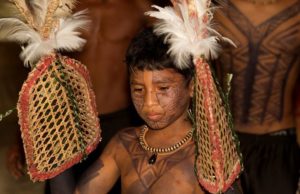
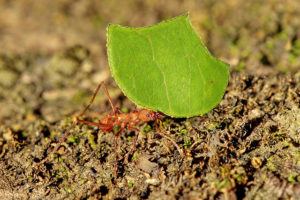 insects (most bees, wasps, other ants, and termites too) live in colonies. Within these colonies, the jobs of scouting for and collecting food, defending against enemies, nest building, reproduction, and myriad other tasks are divided among members of the colony specialized for each role. Typically, a particular body anatomy is associated with such specialization. This allows the job to be done with utmost efficiency. Such division of labor bears an uncanny resemblance to the manner in which the jobs within human society are divvied up. The specialized body forms/occupations within a colony of social insects are referred to as castes.
insects (most bees, wasps, other ants, and termites too) live in colonies. Within these colonies, the jobs of scouting for and collecting food, defending against enemies, nest building, reproduction, and myriad other tasks are divided among members of the colony specialized for each role. Typically, a particular body anatomy is associated with such specialization. This allows the job to be done with utmost efficiency. Such division of labor bears an uncanny resemblance to the manner in which the jobs within human society are divvied up. The specialized body forms/occupations within a colony of social insects are referred to as castes. member is the lone queen who measures about 20 mm in length. Her primary job is to lay the eggs from which all other colony members are derived. Males form another caste but they are short-lived and their only function is to mate with the queen. Shortly after doing so they die, so most colonies are absent of males for long stretches of time. The remaining members of the leafcutter ant colony belong to the worker caste of sterile females which may number four or five million. The leafcutter worker caste is further subdivided based upon size into minims, minors, media, and majors. Each of these performs some specific job or jobs within the colony. Minims (2 mm) work inside the nest, tending larvae for example. These nests, by the way, can be huge. I once saw a leafcutter nest (they look something like an expanse of tilled soil) in the Manu region of
member is the lone queen who measures about 20 mm in length. Her primary job is to lay the eggs from which all other colony members are derived. Males form another caste but they are short-lived and their only function is to mate with the queen. Shortly after doing so they die, so most colonies are absent of males for long stretches of time. The remaining members of the leafcutter ant colony belong to the worker caste of sterile females which may number four or five million. The leafcutter worker caste is further subdivided based upon size into minims, minors, media, and majors. Each of these performs some specific job or jobs within the colony. Minims (2 mm) work inside the nest, tending larvae for example. These nests, by the way, can be huge. I once saw a leafcutter nest (they look something like an expanse of tilled soil) in the Manu region of 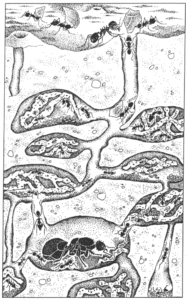 Peru which was forty feet in diameter. Such a nest can go downward into the ground thirty or forty feet and may contain hundreds of interconnected subterranean chambers. Minors protect their foraging sisters and help defend the nest from enemies. Members of the media caste (10 mm) locate food, cut leaves, and transport them back to the nest. The major caste members are large (15-20 mm) with massive heads which house powerful muscles for operating their huge mandibles. These ants are often simply referred to as soldiers and their primary job is defending the colony against attack.
Peru which was forty feet in diameter. Such a nest can go downward into the ground thirty or forty feet and may contain hundreds of interconnected subterranean chambers. Minors protect their foraging sisters and help defend the nest from enemies. Members of the media caste (10 mm) locate food, cut leaves, and transport them back to the nest. The major caste members are large (15-20 mm) with massive heads which house powerful muscles for operating their huge mandibles. These ants are often simply referred to as soldiers and their primary job is defending the colony against attack. The variety of defensive chemicals produced is impressive and includes cardiac and cyanogenic glycosides, calcium oxalate, caffeine, nicotine, and terpenoids. Some of these chemicals cause a bad taste, some burn the mouth, others may cause nausea, and certain others may attack an animal’s nervous or cardiovascular system. Unsurprisingly, some plants produce chemicals which are toxic to the fungus that is grown by the ants (the aforementioned terpenoids for example). Such plants are identified and studiously avoided by the ants lest they bring back toxic leaves which would decimate their primary food source – the fungus garden.
The variety of defensive chemicals produced is impressive and includes cardiac and cyanogenic glycosides, calcium oxalate, caffeine, nicotine, and terpenoids. Some of these chemicals cause a bad taste, some burn the mouth, others may cause nausea, and certain others may attack an animal’s nervous or cardiovascular system. Unsurprisingly, some plants produce chemicals which are toxic to the fungus that is grown by the ants (the aforementioned terpenoids for example). Such plants are identified and studiously avoided by the ants lest they bring back toxic leaves which would decimate their primary food source – the fungus garden.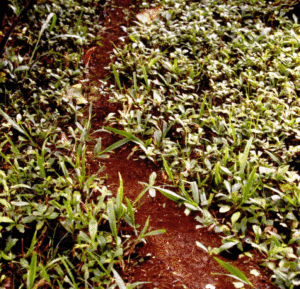 they transport their leaf bits. Media workers build and maintain these trails. Their paths remind me of little, miniature versions of well-trodden human footpaths. As media workers age, they are assigned the garbage detail and work to remove dead ant bodies, bits of dead fungus, and decomposing leaf bits. These waste materials are hazardous to the colony and are dumped outside the nest, above ground in a waste midden.
they transport their leaf bits. Media workers build and maintain these trails. Their paths remind me of little, miniature versions of well-trodden human footpaths. As media workers age, they are assigned the garbage detail and work to remove dead ant bodies, bits of dead fungus, and decomposing leaf bits. These waste materials are hazardous to the colony and are dumped outside the nest, above ground in a waste midden.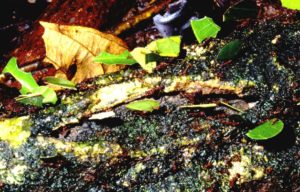
 found, contains a mixture of organic compounds including all the amino acids needed for synthesizing proteins. Since the fungus is unable to break down large protein molecules itself, it relies on the amino acids in the ant rectal fluid to be able to build the protein molecules used for constructing its own mycelial body.
found, contains a mixture of organic compounds including all the amino acids needed for synthesizing proteins. Since the fungus is unable to break down large protein molecules itself, it relies on the amino acids in the ant rectal fluid to be able to build the protein molecules used for constructing its own mycelial body.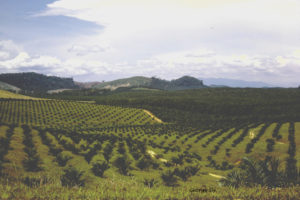
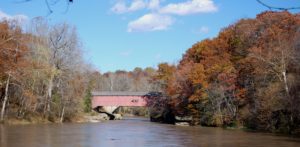
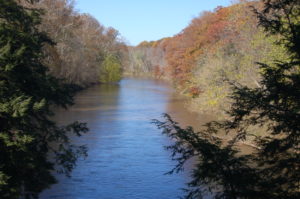
 Jim is gone now. I think about him often and his absence makes my world a lonelier and less interesting place. Jim was an artist whose bright mind roamed the gamut of human endeavors. Music, art itself, science, politics, literature and film; all these fell within his expansive sphere of interests. He could engage in an informed discourse on any of them. He was a man of mercurial temperament who suffered fools poorly. Jim had little tolerance for those who failed to meet the high standards of his broad-minded world view. He could be as explosive as a fumbled vial of nitroglycerine and was especially prone to direct his wrath toward inflexible, narrow minded religious dogma and its attendant intolerance. Politicians were another favored target of his wrath. Woe unto any public servants who traded in the goods which were anathema to Jim – hypocrisy, prejudices, disdain for the environment. His energetic, agile mind – which was prone to roam in unorthodox and inventive directions – was a constant stimulant prompting me in turn to seek, question, and consider. It was wonderfully entertaining to be around him. Jim, in his later years, described himself as an Alchemical Artist. I had always perceived this ancient science as merely a search for the skill of transforming lead into gold, a narcissistic pathway to wealth. But Jim’s exploration and comprehension of alchemy ran much deeper. He described alchemy to me as “. . . a complex and mysterious philosophy which involved a transformation process that sought spiritual renewal and an understanding of both the composition of the universe and how it worked.” A search for theology from a friend who decried organized religion? A quest in the realm of cosmology from one trained in art? Alchemy as the pursuit of spiritual and intellectual gold? These apparent contradictions made me even more aware of the depth of Jim’s interests, astuteness, and beliefs. In light of this, I was intrigued when I ran across author Edward Abbey’s reference to alchemy in describing a close friend of his own, the artist John De Puy . In reference to Du Puy’s brilliance, accompanied by a steady, purposeful intake of strong drink, Abbey said, “I suspected more than alcohol at work here. But the drug, as I would eventually understand, was not chemical but alchemical: the alkaloids of genius.” The alkaloids of genius were surely present in James Loney as well. What more can I say? Jim was the most interesting, thought-provoking person I have ever known. His was the irreplaceable friendship of a lifetime.
Jim is gone now. I think about him often and his absence makes my world a lonelier and less interesting place. Jim was an artist whose bright mind roamed the gamut of human endeavors. Music, art itself, science, politics, literature and film; all these fell within his expansive sphere of interests. He could engage in an informed discourse on any of them. He was a man of mercurial temperament who suffered fools poorly. Jim had little tolerance for those who failed to meet the high standards of his broad-minded world view. He could be as explosive as a fumbled vial of nitroglycerine and was especially prone to direct his wrath toward inflexible, narrow minded religious dogma and its attendant intolerance. Politicians were another favored target of his wrath. Woe unto any public servants who traded in the goods which were anathema to Jim – hypocrisy, prejudices, disdain for the environment. His energetic, agile mind – which was prone to roam in unorthodox and inventive directions – was a constant stimulant prompting me in turn to seek, question, and consider. It was wonderfully entertaining to be around him. Jim, in his later years, described himself as an Alchemical Artist. I had always perceived this ancient science as merely a search for the skill of transforming lead into gold, a narcissistic pathway to wealth. But Jim’s exploration and comprehension of alchemy ran much deeper. He described alchemy to me as “. . . a complex and mysterious philosophy which involved a transformation process that sought spiritual renewal and an understanding of both the composition of the universe and how it worked.” A search for theology from a friend who decried organized religion? A quest in the realm of cosmology from one trained in art? Alchemy as the pursuit of spiritual and intellectual gold? These apparent contradictions made me even more aware of the depth of Jim’s interests, astuteness, and beliefs. In light of this, I was intrigued when I ran across author Edward Abbey’s reference to alchemy in describing a close friend of his own, the artist John De Puy . In reference to Du Puy’s brilliance, accompanied by a steady, purposeful intake of strong drink, Abbey said, “I suspected more than alcohol at work here. But the drug, as I would eventually understand, was not chemical but alchemical: the alkaloids of genius.” The alkaloids of genius were surely present in James Loney as well. What more can I say? Jim was the most interesting, thought-provoking person I have ever known. His was the irreplaceable friendship of a lifetime. Game fishes are present too. Catfish, bass, bluegill, and crappie swim the waters of Sugar Creek. The stream is considered by many to be the best fishing area for smallmouth bass in the state. Admittedly the fishing Jim and I did was accomplished in a casual sort of way. There were many other subjects of which to speak, other curiosities to consider. We made periodic casts but often simply let the night-crawlers on their harnesses troll along beside the canoe. It seems strange to me, after the passage of so many years, that the strike of the first fish remains so vivid in my memory. The deep pool cutting against the bank as the stream made its bend, the angle and intensity of the sunlight, the excited yells, and the agitated efforts we made to get the canoe turned and stopped, all are as fresh in my mind now as when I saw the tip of my rod whip toward the water’s surface. We did manage to get pulled onto the sandbar on the inside of the bend. We sat there and cast into the small, swift running pool (it couldn’t have been more than ten yards long) and time after time were rewarded. It seemed that every smallmouth bass and channel cat in this stretch of Sugar Creek had taken refuge in this one little spot. What a wonderful time we had.
Game fishes are present too. Catfish, bass, bluegill, and crappie swim the waters of Sugar Creek. The stream is considered by many to be the best fishing area for smallmouth bass in the state. Admittedly the fishing Jim and I did was accomplished in a casual sort of way. There were many other subjects of which to speak, other curiosities to consider. We made periodic casts but often simply let the night-crawlers on their harnesses troll along beside the canoe. It seems strange to me, after the passage of so many years, that the strike of the first fish remains so vivid in my memory. The deep pool cutting against the bank as the stream made its bend, the angle and intensity of the sunlight, the excited yells, and the agitated efforts we made to get the canoe turned and stopped, all are as fresh in my mind now as when I saw the tip of my rod whip toward the water’s surface. We did manage to get pulled onto the sandbar on the inside of the bend. We sat there and cast into the small, swift running pool (it couldn’t have been more than ten yards long) and time after time were rewarded. It seemed that every smallmouth bass and channel cat in this stretch of Sugar Creek had taken refuge in this one little spot. What a wonderful time we had. 
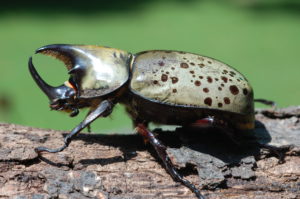 discovered a species of beetle that was previously unknown to science. Knowing whether or not one has a new species in hand requires expertise of course. Thus it is that one will find specialists in the taxonomy (identification and classification) of any particular group of organisms one wishes to choose. Some taxonomists go for the gold and tackle a group with charismatic star-power such as the dinosaurs. Others may, with forethought, choose a group of organisms in which taxonomic competition among biologists is less intense. Harvard entomology professor emeritus E.O. Wilson chose to become a myrmecologist (ant biologist) and in the process carved himself a niche within which he holds sway as the world’s acknowledged expert on this group. Some biologists will opt for an even more arcane group. This almost certainly guarantees them supremacy of expertise in their chosen area.
discovered a species of beetle that was previously unknown to science. Knowing whether or not one has a new species in hand requires expertise of course. Thus it is that one will find specialists in the taxonomy (identification and classification) of any particular group of organisms one wishes to choose. Some taxonomists go for the gold and tackle a group with charismatic star-power such as the dinosaurs. Others may, with forethought, choose a group of organisms in which taxonomic competition among biologists is less intense. Harvard entomology professor emeritus E.O. Wilson chose to become a myrmecologist (ant biologist) and in the process carved himself a niche within which he holds sway as the world’s acknowledged expert on this group. Some biologists will opt for an even more arcane group. This almost certainly guarantees them supremacy of expertise in their chosen area.  For example, when I was in graduate school, one of the professors in our department was an expert on the taxonomy of psocids. You may rightly ask, what in the world is a psocid? Many psocids look like tiny flies. Others, being wingless, resemble lice. Technically speaking, they belong to a group of insects known as booklice. They are quite small, one or two millimeters in length, and feed on lichens and fungi. Psocids often perch on shrubby vegetation. This particular professor could regularly be seen wandering about the campus with the tools of his trade – a black umbrella, a stout club, and an aspirator. Upon approaching a shrub, he would open the umbrella, hold it upside down under the vegetation, and suddenly begin flailing the branches with his club as though possessed by the sudden onset of some sort of mania. This frantic and, to outward appearance, bizarre routine would be met with open-mouthed astonishment by passersby. It really was quite entertaining to watch him at work. Of course, he was collecting psocids. Pummeling the shrubbery would cause any psocids present to fall onto the black umbrella. Here, despite their tiny size, the whitish body color would make them readily apparent. The aspirator was essentially a test tube with a stopper in it. From the stopper protruded two tubes. One was a short glass piece which the prof placed in his mouth. The other was a longer plastic tube which was positioned next to a psocid perched on the umbrella. A gentle suction applied to the glass tube resulted in the psocid being vacuumed into the test tube. A very interesting operation it was and one which made me admire the entertaining eccentricity of many scientists even more.
For example, when I was in graduate school, one of the professors in our department was an expert on the taxonomy of psocids. You may rightly ask, what in the world is a psocid? Many psocids look like tiny flies. Others, being wingless, resemble lice. Technically speaking, they belong to a group of insects known as booklice. They are quite small, one or two millimeters in length, and feed on lichens and fungi. Psocids often perch on shrubby vegetation. This particular professor could regularly be seen wandering about the campus with the tools of his trade – a black umbrella, a stout club, and an aspirator. Upon approaching a shrub, he would open the umbrella, hold it upside down under the vegetation, and suddenly begin flailing the branches with his club as though possessed by the sudden onset of some sort of mania. This frantic and, to outward appearance, bizarre routine would be met with open-mouthed astonishment by passersby. It really was quite entertaining to watch him at work. Of course, he was collecting psocids. Pummeling the shrubbery would cause any psocids present to fall onto the black umbrella. Here, despite their tiny size, the whitish body color would make them readily apparent. The aspirator was essentially a test tube with a stopper in it. From the stopper protruded two tubes. One was a short glass piece which the prof placed in his mouth. The other was a longer plastic tube which was positioned next to a psocid perched on the umbrella. A gentle suction applied to the glass tube resulted in the psocid being vacuumed into the test tube. A very interesting operation it was and one which made me admire the entertaining eccentricity of many scientists even more. The research station sat along the main trunk road which led from Kuala Lumpur, near the west coast, to the city of Kuantan lying hard by the South China Sea to the east. The facility was comprised of two buildings. One served as a laboratory where specimens collected during our forays into the rainforest could be identified, observed, and catalogued. The other building contained dormitories for the students, two small private rooms for staff, and a kitchen where the three meals students and staff took each day were prepared. In front of the dormitory, a small but well-manicured lawn sloped downward toward the nearby forest edge and the Sungei Gombak which flowed just inside the wall of trees. Although called a river, this stream was only a few yards across. I suppose a world-class long-jumper could have cleared it in a single leap. Nevertheless, the stream’s constant, muffled roar was a pleasant addition to the symphony of rainforest sounds falling steadily upon one’s ear. The stream was also a fruitful site should one want to search for caecilian larvae or foam-nesting tree frogs.
The research station sat along the main trunk road which led from Kuala Lumpur, near the west coast, to the city of Kuantan lying hard by the South China Sea to the east. The facility was comprised of two buildings. One served as a laboratory where specimens collected during our forays into the rainforest could be identified, observed, and catalogued. The other building contained dormitories for the students, two small private rooms for staff, and a kitchen where the three meals students and staff took each day were prepared. In front of the dormitory, a small but well-manicured lawn sloped downward toward the nearby forest edge and the Sungei Gombak which flowed just inside the wall of trees. Although called a river, this stream was only a few yards across. I suppose a world-class long-jumper could have cleared it in a single leap. Nevertheless, the stream’s constant, muffled roar was a pleasant addition to the symphony of rainforest sounds falling steadily upon one’s ear. The stream was also a fruitful site should one want to search for caecilian larvae or foam-nesting tree frogs. company with the cheery Malay students. All the while we could gaze out onto the nearby mountains, their slopes cloaked with a thick covering of dipterocarp forest.
company with the cheery Malay students. All the while we could gaze out onto the nearby mountains, their slopes cloaked with a thick covering of dipterocarp forest. 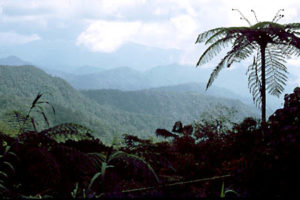 The superstars of this forest were the massive Shorea trees whose grayish- leaves caused them to stand out among the numberless greens of their brethren. Some of these Shorea were giants who towered over two-hundred feet above the forest floor. Occasionally a guttural call or a thrashing, leafy branch would alert us to the presence of a band of dusky or silvered leaf monkeys moving through the canopy. A flying lizard (Draco) might be seen soaring across the lawn its rapid, direct “flight” causing one to momentarily mistake it for a bird. On more than one occasion, the morning was embellished by a flyover of one of the rainforests largest birds, the rhinoceros hornbill. Occasionally the flight would be announced by the magnificent bird’s ringing, honking call. At other times the hornbill might pass above us without voice, its presence announced only by the deep, far-carrying sound from the beats of its five feet long wingspan.
The superstars of this forest were the massive Shorea trees whose grayish- leaves caused them to stand out among the numberless greens of their brethren. Some of these Shorea were giants who towered over two-hundred feet above the forest floor. Occasionally a guttural call or a thrashing, leafy branch would alert us to the presence of a band of dusky or silvered leaf monkeys moving through the canopy. A flying lizard (Draco) might be seen soaring across the lawn its rapid, direct “flight” causing one to momentarily mistake it for a bird. On more than one occasion, the morning was embellished by a flyover of one of the rainforests largest birds, the rhinoceros hornbill. Occasionally the flight would be announced by the magnificent bird’s ringing, honking call. At other times the hornbill might pass above us without voice, its presence announced only by the deep, far-carrying sound from the beats of its five feet long wingspan. 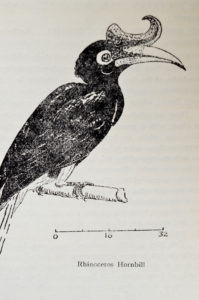 They reminded me of the chugging of a slow moving steam locomotive. Breakfasts were often graced by the exotic, high-pitched whooping of white-handed gibbons or the deep, booming voice of siamangs issuing from the far hills as they performed their morning routine of establishing territorial boundaries and maintaining the unity of their groups. Looking back I recall a magical place, a kind of Eden where I found myself joyous simply to be alive, euphoric over my good fortune in being present in one of planet earth’s last, great wild places.
They reminded me of the chugging of a slow moving steam locomotive. Breakfasts were often graced by the exotic, high-pitched whooping of white-handed gibbons or the deep, booming voice of siamangs issuing from the far hills as they performed their morning routine of establishing territorial boundaries and maintaining the unity of their groups. Looking back I recall a magical place, a kind of Eden where I found myself joyous simply to be alive, euphoric over my good fortune in being present in one of planet earth’s last, great wild places.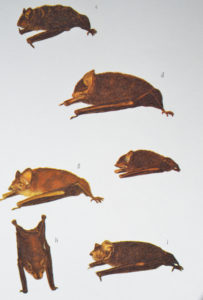
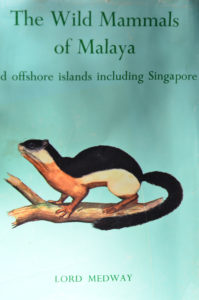 authoritative source of information on the mammals of Malaysia. Scanning through the tube-nosed bat descriptions, I found the closest match to be one with the common moniker of bronzed tube-nosed bat. It seemed pretty straight forward but, as I read the species description in Medway, I was startled. The text stated that not only was this bat known only from Malaysia, it was known from a single specimen taken in the neighboring state of Pahang. With rising pulse rate, I again ran through the measurements, observed the coloration, and referred to Medway’s description. I again came up with bronzed tube-nosed bat. Still not convinced that I hadn’t made an error in utilizing the taxonomic key, I ran through the characters a third time. Again the final couplet of the key led to Murina aenea, the bronzed tube-nosed bat.
authoritative source of information on the mammals of Malaysia. Scanning through the tube-nosed bat descriptions, I found the closest match to be one with the common moniker of bronzed tube-nosed bat. It seemed pretty straight forward but, as I read the species description in Medway, I was startled. The text stated that not only was this bat known only from Malaysia, it was known from a single specimen taken in the neighboring state of Pahang. With rising pulse rate, I again ran through the measurements, observed the coloration, and referred to Medway’s description. I again came up with bronzed tube-nosed bat. Still not convinced that I hadn’t made an error in utilizing the taxonomic key, I ran through the characters a third time. Again the final couplet of the key led to Murina aenea, the bronzed tube-nosed bat.
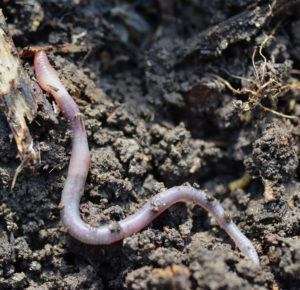 I speak of Lumbricus, Aporrectodea, Diplocardia and their ilk. Local fisher-folk may refer to them as night crawler, red worm, wriggler, or dew worm. Earthworms belong to a widely distributed and biologically successful group known as the annelid worms. They are so-called because of the division of the body into small, ring-like segments (annuli). Leeches and certain marine worms are also annelids. But it is earthworms that are involved in this story.
I speak of Lumbricus, Aporrectodea, Diplocardia and their ilk. Local fisher-folk may refer to them as night crawler, red worm, wriggler, or dew worm. Earthworms belong to a widely distributed and biologically successful group known as the annelid worms. They are so-called because of the division of the body into small, ring-like segments (annuli). Leeches and certain marine worms are also annelids. But it is earthworms that are involved in this story.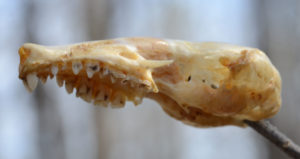 Slowly inching forward by taking mouthful after mouthful of soil; it would be fortunate that our tiny brain could not foresee the inevitable, gruesome end as three dozen sharply pointed teeth render us into mole fodder.
Slowly inching forward by taking mouthful after mouthful of soil; it would be fortunate that our tiny brain could not foresee the inevitable, gruesome end as three dozen sharply pointed teeth render us into mole fodder.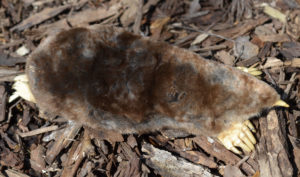 through the topsoil. I really was quite flabbergasted as I made the connection between the emergent flight of the earthworms and the sudden appearance of the mole. It was rather obvious that the worms were sensitive to the vibrations produced by the approaching mole and had taken to the surface in a last ditch effort to avoid becoming a meal. To me this seemed a remarkable piece of behavior from animals with a brain about the size of the period at the end of this sentence. If the worms recognized the vibrations as a threat, did this imply that they could remember? Didn’t this behavior suggest not only the capacity of memory but, more specifically, the ability to recall that the vibrations were produced by their arch nemesis, the mole? Did this indicate that they then had to analyze this memory and decide upon an appropriate response? In other words, were they actually capable of advanced neural integration? I don’t want to be anthropomorphic but the earthworm equivalent of memory, integration, and response borders on what I had always assumed were marks of intelligence. Darwin, in his aforementioned studies, devised experiments to observe how worms handled leaf material of different shapes. The results suggested to him that they did possess intelligence. He compared their abilities to the highly developed dexterous sense possessed by people who are deprived of sight.
through the topsoil. I really was quite flabbergasted as I made the connection between the emergent flight of the earthworms and the sudden appearance of the mole. It was rather obvious that the worms were sensitive to the vibrations produced by the approaching mole and had taken to the surface in a last ditch effort to avoid becoming a meal. To me this seemed a remarkable piece of behavior from animals with a brain about the size of the period at the end of this sentence. If the worms recognized the vibrations as a threat, did this imply that they could remember? Didn’t this behavior suggest not only the capacity of memory but, more specifically, the ability to recall that the vibrations were produced by their arch nemesis, the mole? Did this indicate that they then had to analyze this memory and decide upon an appropriate response? In other words, were they actually capable of advanced neural integration? I don’t want to be anthropomorphic but the earthworm equivalent of memory, integration, and response borders on what I had always assumed were marks of intelligence. Darwin, in his aforementioned studies, devised experiments to observe how worms handled leaf material of different shapes. The results suggested to him that they did possess intelligence. He compared their abilities to the highly developed dexterous sense possessed by people who are deprived of sight.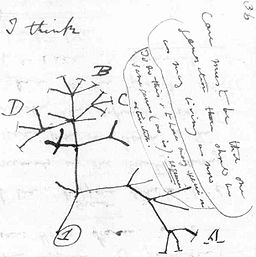
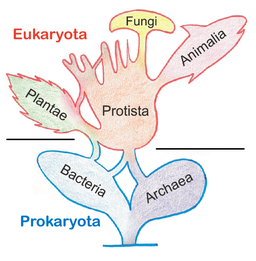
 that populate the billions of galaxies of our universe. From some of these stars, the elements that, so far as we know, comprise all matter were then generated. The calcium in our bones, the nitrogen in our DNA, the gold filling in our tooth, all these have been forged from the titanic forces generated by exploding stars. Once formed, the elements have yielded molecules and compounds which have made possible the evolution of life itself. From the first primitive cells, whose precise origins are lost in the vapors of time, have arisen all of the organisms, simple to complex, which have graced the earth.
that populate the billions of galaxies of our universe. From some of these stars, the elements that, so far as we know, comprise all matter were then generated. The calcium in our bones, the nitrogen in our DNA, the gold filling in our tooth, all these have been forged from the titanic forces generated by exploding stars. Once formed, the elements have yielded molecules and compounds which have made possible the evolution of life itself. From the first primitive cells, whose precise origins are lost in the vapors of time, have arisen all of the organisms, simple to complex, which have graced the earth. land I now walked upon was once the bottom of a sea. Further east the Appalachians had risen to snow-capped heights rivaling the Rockies. Over the eons, the ravages of wind, water, and ice have reduced them to their present aspect of rounded, rolling domes – the Smoky Mountains. The very continents themselves, we now know, wander restlessly over the earth’s mantle. Viewed from space, the visage of earth today is very different than when the dry lands were merged to form the immense super-continent known as Pangaea.
land I now walked upon was once the bottom of a sea. Further east the Appalachians had risen to snow-capped heights rivaling the Rockies. Over the eons, the ravages of wind, water, and ice have reduced them to their present aspect of rounded, rolling domes – the Smoky Mountains. The very continents themselves, we now know, wander restlessly over the earth’s mantle. Viewed from space, the visage of earth today is very different than when the dry lands were merged to form the immense super-continent known as Pangaea. the arthropods also came to be the dominate invertebrates of the dry lands of the planet. Today nearly one million species of insects alone are known to science. The echinoderms, the spiny-skinned starfish and urchins, in their rich variety dispersed themselves through the earth’s vast oceans. Descendants of this group became the ancestors of the fishes which eventually claimed dominion over the waters of the world. From one group of ancient fish antecedents came the audacious back-boned creatures which first climbed from the water and into the forbidding world of air and sun. Thus, the first amphibians evolved some four hundred million years ago. Over the next three hundred million years there emerged the reptiles, the birds, the mammals. For over one hundred and fifty million years, the dinosaurs reigned as the dominant group of terrestrial vertebrates.
the arthropods also came to be the dominate invertebrates of the dry lands of the planet. Today nearly one million species of insects alone are known to science. The echinoderms, the spiny-skinned starfish and urchins, in their rich variety dispersed themselves through the earth’s vast oceans. Descendants of this group became the ancestors of the fishes which eventually claimed dominion over the waters of the world. From one group of ancient fish antecedents came the audacious back-boned creatures which first climbed from the water and into the forbidding world of air and sun. Thus, the first amphibians evolved some four hundred million years ago. Over the next three hundred million years there emerged the reptiles, the birds, the mammals. For over one hundred and fifty million years, the dinosaurs reigned as the dominant group of terrestrial vertebrates.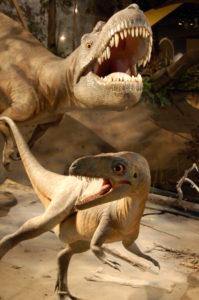 The sudden extinction of the dinosaurs allowed birds, descendants of theropod dinosaurs, to take a turn as the most biologically successful of vertebrates. They were joined in this new world order by the mammals, themselves descended from reptilian ancestors known as synapsids.
The sudden extinction of the dinosaurs allowed birds, descendants of theropod dinosaurs, to take a turn as the most biologically successful of vertebrates. They were joined in this new world order by the mammals, themselves descended from reptilian ancestors known as synapsids.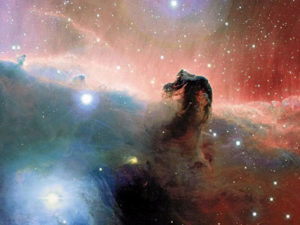 extraordinary event . . . that brings very welcome consequences. In my contemplation of life on earth, this seems to fit what has happened. I find the mere fact of my own existence, let alone the plethora of earth’s organisms past and present, extraordinary. I certainly consider the wondrous biodiversity of our planet a welcome consequence. It is vanity I suppose that compels me to also consider my own existence a welcome consequence of the unfolding universe story.
extraordinary event . . . that brings very welcome consequences. In my contemplation of life on earth, this seems to fit what has happened. I find the mere fact of my own existence, let alone the plethora of earth’s organisms past and present, extraordinary. I certainly consider the wondrous biodiversity of our planet a welcome consequence. It is vanity I suppose that compels me to also consider my own existence a welcome consequence of the unfolding universe story. Darwin was correct about a good many things. Perhaps he was in this case also.
Darwin was correct about a good many things. Perhaps he was in this case also.
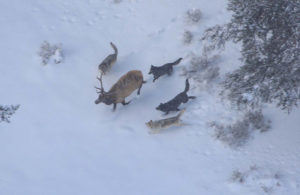 The reduction of elk numbers within the park has had some interesting ecological ripple effects. With the reintroduction of wolves, elk were no longer able to unconcernedly loaf about in the stream valleys of the park. Here they had browsed heavily upon riparian vegetation such as willow, cottonwood, and aspen trees. With the number of elk reduced, tree growth flourished. This in turn has led to an increase in the number of beavers within the park. These rodents eat the bark of trees such as willow; they also use the branches and logs cut from such trees to construct their dams and lodges. More beavers mean more beaver ponds. As a result there has been an increase in available habitat for waterfowl such as ducks, geese, and swans. Improved riparian habitat is also beneficial to songbirds (nesting habitat), trout (less siltation into streams), and moose (more browse and cover). Others animals which have benefited from the reintroduction of wolves in Yellowstone include scavengers such as ravens, eagles, and bears which may feed on the remains of wolf kills. The coyote population within Yellowstone NP was also cut by fifty percent. Wolves will kill coyotes and both species will prey upon the others’ pups given the chance. When wolves were removed from the park, the population of coyotes increased greatly. Coyotes are too small to prey upon elk but they were the primary predator upon pronghorn antelope calves. When coyote numbers were reduced by the presence of wolves once again, the population of antelopes in the park underwent an increase. Coyotes also compete with foxes and so populations of the latter have also gone up as a result of the presence of wolves. This so-called trophic cascade of impacts shows what a restored keystone species can accomplish given the opportunity and the time.
The reduction of elk numbers within the park has had some interesting ecological ripple effects. With the reintroduction of wolves, elk were no longer able to unconcernedly loaf about in the stream valleys of the park. Here they had browsed heavily upon riparian vegetation such as willow, cottonwood, and aspen trees. With the number of elk reduced, tree growth flourished. This in turn has led to an increase in the number of beavers within the park. These rodents eat the bark of trees such as willow; they also use the branches and logs cut from such trees to construct their dams and lodges. More beavers mean more beaver ponds. As a result there has been an increase in available habitat for waterfowl such as ducks, geese, and swans. Improved riparian habitat is also beneficial to songbirds (nesting habitat), trout (less siltation into streams), and moose (more browse and cover). Others animals which have benefited from the reintroduction of wolves in Yellowstone include scavengers such as ravens, eagles, and bears which may feed on the remains of wolf kills. The coyote population within Yellowstone NP was also cut by fifty percent. Wolves will kill coyotes and both species will prey upon the others’ pups given the chance. When wolves were removed from the park, the population of coyotes increased greatly. Coyotes are too small to prey upon elk but they were the primary predator upon pronghorn antelope calves. When coyote numbers were reduced by the presence of wolves once again, the population of antelopes in the park underwent an increase. Coyotes also compete with foxes and so populations of the latter have also gone up as a result of the presence of wolves. This so-called trophic cascade of impacts shows what a restored keystone species can accomplish given the opportunity and the time. There were grins all around and glances were exchanged that asked, was that really a wolf? But yes, it was. There was no mistaking this deep, chesty, bawl for the high-pitched yapping of a coyote. We really had heard a wild gray wolf.
There were grins all around and glances were exchanged that asked, was that really a wolf? But yes, it was. There was no mistaking this deep, chesty, bawl for the high-pitched yapping of a coyote. We really had heard a wild gray wolf. What beautiful birds they are. The female, like most members of the avian clan, shows her beauty in an understated perfection of camouflage. Just this morning, I watched her perched in the ash tree near the nest box. Shifting my gaze caused me to struggle a bit to relocate her feathered body of subtle browns and mottled breast. The male showed no need for such subtlety. The wild, orange-red eyes and beak were set upon a head of iridescent green marked with bold highlights of white. The chestnut breast and fawn flanks were overlain by a back that seemed black but suddenly morphed into lustrous emerald when he shifted position and the morning light struck from a different angle. One would be hard-pressed to find another North American bird which surpasses the beauty of a male wood duck.
What beautiful birds they are. The female, like most members of the avian clan, shows her beauty in an understated perfection of camouflage. Just this morning, I watched her perched in the ash tree near the nest box. Shifting my gaze caused me to struggle a bit to relocate her feathered body of subtle browns and mottled breast. The male showed no need for such subtlety. The wild, orange-red eyes and beak were set upon a head of iridescent green marked with bold highlights of white. The chestnut breast and fawn flanks were overlain by a back that seemed black but suddenly morphed into lustrous emerald when he shifted position and the morning light struck from a different angle. One would be hard-pressed to find another North American bird which surpasses the beauty of a male wood duck.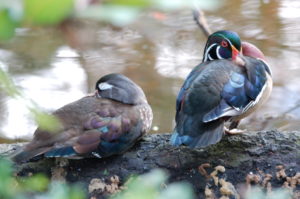 The duck escaped but barely. The male I saw this morning appeared again later in the day. This time with a red-shouldered hawk tailing him and showing what seemed a sinister interest. Yes, I think sneaking in and out of the nest box is a good idea.
The duck escaped but barely. The male I saw this morning appeared again later in the day. This time with a red-shouldered hawk tailing him and showing what seemed a sinister interest. Yes, I think sneaking in and out of the nest box is a good idea.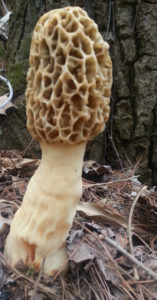 Successfully finding morels is something of a knack. Hunters who can spot a tiny morel at thirty paces and come home from a quest with bulging sacks of these delicacies are highly regarded in these parts. I dare say that I hold such a person in much higher esteem than a typical member of the Indiana legislature. I love to mushroom hunt but few would consider me an adept in this art. Nevertheless, along with my wife and daughter, we find our share. Weekends spent searching our woodlands for black, half-free, gray, and yellow morels have provided many an hour of pleasant companionship for us.
Successfully finding morels is something of a knack. Hunters who can spot a tiny morel at thirty paces and come home from a quest with bulging sacks of these delicacies are highly regarded in these parts. I dare say that I hold such a person in much higher esteem than a typical member of the Indiana legislature. I love to mushroom hunt but few would consider me an adept in this art. Nevertheless, along with my wife and daughter, we find our share. Weekends spent searching our woodlands for black, half-free, gray, and yellow morels have provided many an hour of pleasant companionship for us.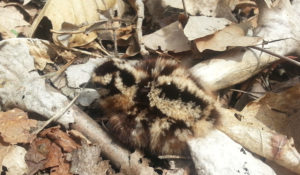 Tiny little balls of downy fluff they were. Their coloration was so cryptic and matched the dead leaves upon which they sat so well that I was somewhat astonished to have even spotted them. Not a millimeter did they move. Not an eye blinked. I carefully reached down and touched a down feather. Still as stone the crafty little mote remained. By such instinct do they remain invisible to fox and weasel. I slowly moved away secure in the knowledge that mom, listening intently just over the ridge, would soon return and lead the little brood away. Who could think of morels when bequeathed such a rare glimpse into the secret life of the woodcock?
Tiny little balls of downy fluff they were. Their coloration was so cryptic and matched the dead leaves upon which they sat so well that I was somewhat astonished to have even spotted them. Not a millimeter did they move. Not an eye blinked. I carefully reached down and touched a down feather. Still as stone the crafty little mote remained. By such instinct do they remain invisible to fox and weasel. I slowly moved away secure in the knowledge that mom, listening intently just over the ridge, would soon return and lead the little brood away. Who could think of morels when bequeathed such a rare glimpse into the secret life of the woodcock?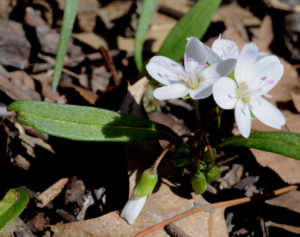 Digging into the soil I retrieve a filbert sized corm from one of the plants. Brushing away the soil, I pop the morsel into my mouth, crunch down, and am rewarded with an earthy, potato flavor. Nearby stands half a dozen specimens of toothwort. This small, white-flowered herbaceous plant is quite common in the woodlands of Indiana. I recall that the name refers to use of the plant’s segmented root as an herbal remedy for toothache. This in turn causes me to ponder upon the fact that
Digging into the soil I retrieve a filbert sized corm from one of the plants. Brushing away the soil, I pop the morsel into my mouth, crunch down, and am rewarded with an earthy, potato flavor. Nearby stands half a dozen specimens of toothwort. This small, white-flowered herbaceous plant is quite common in the woodlands of Indiana. I recall that the name refers to use of the plant’s segmented root as an herbal remedy for toothache. This in turn causes me to ponder upon the fact that 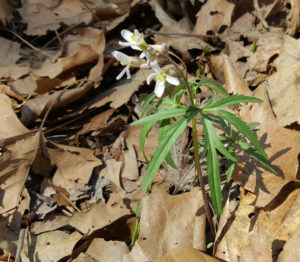 practically every plant I see around me was likely used in some way by Native Americans. Whether it be food, fiber, or building material that was needed, a plant that fit the bill could be found in their environment. The pioneers who displaced the native inhabitants were also aware, likely to a lesser degree, of the natural pharmacy and food larder that surrounded them. Sadly this is a knowledge and skill that is as nearly extinct among modern Hoosiers as the passenger pigeon. My guess is that the vast majority of modern humans are cerebrally disconnected from their continued reliance upon the plant kingdom for our survival. I dig up a small, two inch root of a toothwort and sample its texture and taste. Yes, very crispy as I had heard and it does indeed taste like horseradish.
practically every plant I see around me was likely used in some way by Native Americans. Whether it be food, fiber, or building material that was needed, a plant that fit the bill could be found in their environment. The pioneers who displaced the native inhabitants were also aware, likely to a lesser degree, of the natural pharmacy and food larder that surrounded them. Sadly this is a knowledge and skill that is as nearly extinct among modern Hoosiers as the passenger pigeon. My guess is that the vast majority of modern humans are cerebrally disconnected from their continued reliance upon the plant kingdom for our survival. I dig up a small, two inch root of a toothwort and sample its texture and taste. Yes, very crispy as I had heard and it does indeed taste like horseradish.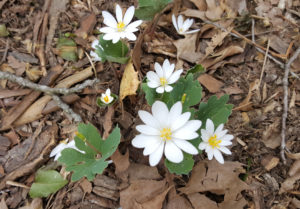 Of course I can’t neglect consideration of the woody plants. Redbud, my favorite, dogwood, and spicebush transform the nearly leafless forest into an impressionist opus. There is so much to see and muse upon here. How could anyone keep their mind on morels?
Of course I can’t neglect consideration of the woody plants. Redbud, my favorite, dogwood, and spicebush transform the nearly leafless forest into an impressionist opus. There is so much to see and muse upon here. How could anyone keep their mind on morels?